In this article we will talk about such a popular material today, as polymer clay. From it you can make a lot of beautiful things.
Contents
- How to work with polymer clay?
- How to bake clay crafts?
- Crafts of polymer clay for beginners:
- master class Crafts from polymer clay
- Plastic clay doll with own hands
- Clay toys with own hands
- Sculptures made of clay with own hands
- Polymer clay cup
- Vase made of polymer clay
- Clay flowerswith their own hands
- Tandoor of clay with their own hands
- Decorations made of polymer clay
- Video: Magic peonies made of polymer clay
- Video: Bunny polymer clay
- Video: Unreal sculptingclay clay
Polymer clay is one of the most common materials for needlework. And it is not surprising, because it is very elastic and completely non-toxic, and crafts are simply fantastic!
And amazing variety of such crafts - not only jewelry, but also many other things that will definitely decorate your life.
How to work with polymer clay?
So, first of all, should be taken care of when working with polymer clay .Half of the success in the work depends on the right choice.
Of course, it is necessary to stock up first of all the clay itself, which is sold in special shops for needlework. Marks exist enough:
- You can buy a domestic version of the type "Tsvetika" - it is inexpensive, but for sausage billets is not good. Color palette is not extensive, special effects like mother-of-pearl, no metal
IMPORTANT: The most notable flaw is that after baking the products from "Tsvetik" become very fragile.
- Of the foreign brands, "FIMO" is considered to be the most widely used - it offers the buyer a wide range of colors that, after baking, do not change much, is suitable for a variety of
- techniques. There are the following types: Soft Soft, Standard Classic and interesting Effect with additives, transparency, sparklesand mother of pearl
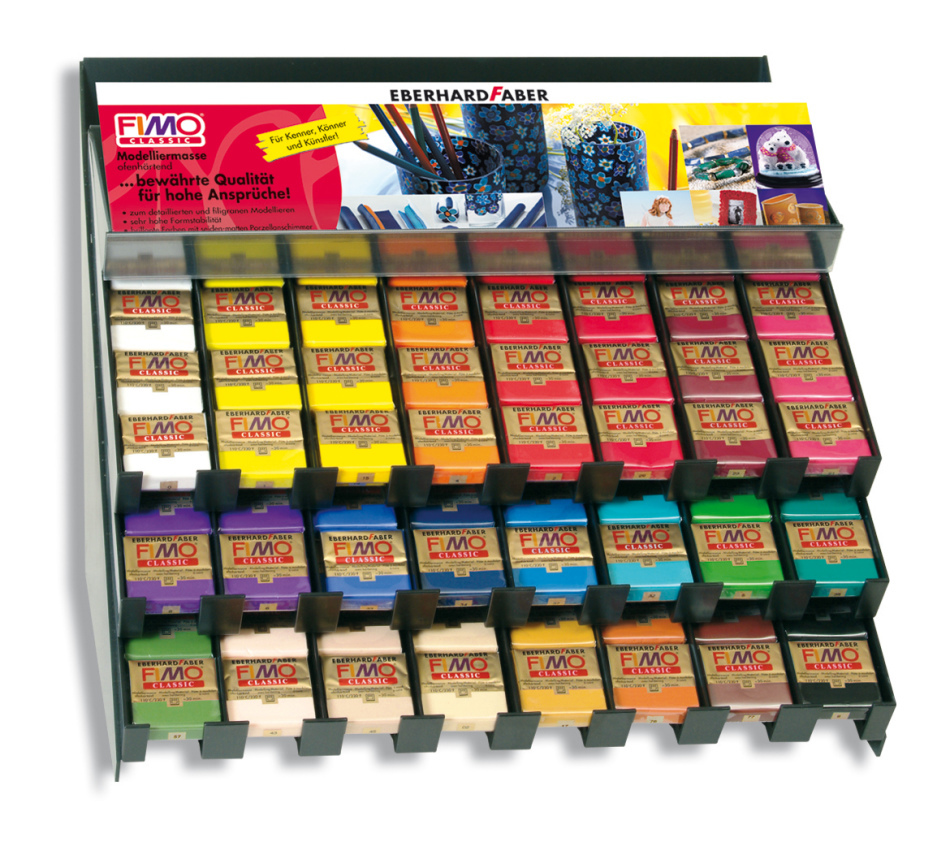 German polymer clay FIMO offers a fairly wide range of colors
German polymer clay FIMO offers a fairly wide range of colors - "Premo" - has a greater similarity to wax than the previous version. It is very easy to mold it. It is well suited for
- "KATO" sausages - this brand will have to suffer a little, as it bakes at a high enough temperature. And as for attempts to stretch the clay, it will be rather problematic to do this if you do not use the
- hammer. You can pay attention to on the Polish products - it is strong, affordable. Well suited for sculptural modeling. However, if you plan to make sausages, this clay is not very suitable for
- "Cernit" - recommended for those who want to sculpt dolls and imitate stones like marble. If you want to bring a clear note to your products, this brand will suit perfectly. Clay is similar to wax, preferably before molding it properly knead
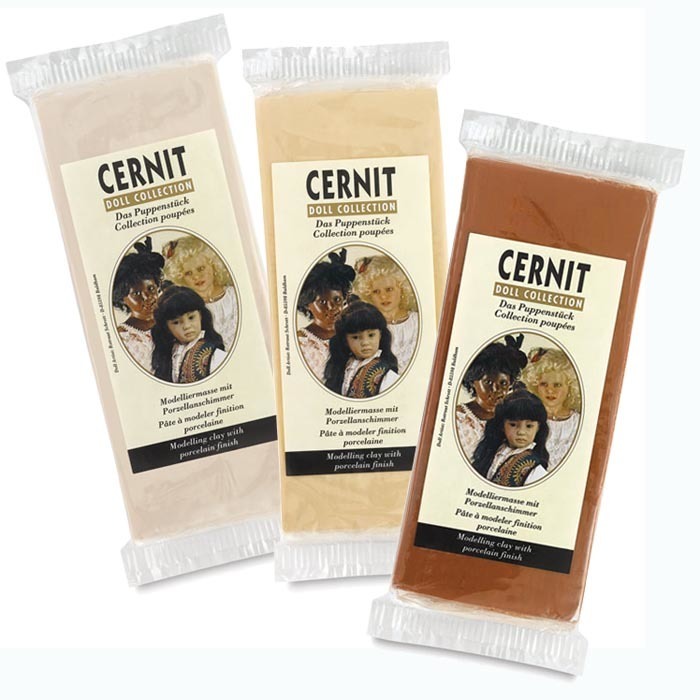 The package of polymer clay Cernit painted dolls - the products that are best made from it
The package of polymer clay Cernit painted dolls - the products that are best made from it What else can not do without the creative process?
- Without the workstation , of course. For this case, it is best to find a tile or a glass, since you will have to work with a knife. You can have a thick sheet of white paper, but this is an extreme case of
- . The knife needs the sharpest, and it is desirable for this kind of work. But if there is not one, you can use clerical. Pay close attention to the sharpening - the material should not be smeared as a result. And look at the price, choosing the "golden mean", because cheap ones are very often stupid, and expensive ones have an excessively thick blade - they include, for example, the Japanese
IMPORTANT: Do not use a kitchen appliance in any way! There is a risk of injuring your health.
 With such blades it is especially convenient to cut the polymer clay
With such blades it is especially convenient to cut the polymer clay - The pin is also indispensable, but not plastic. The fact is that some types of plastic quickly deteriorate under the influence of polymer clay. But you can use a special roller for rolling clay or at all
- Toothpicks well help in making holes in beads, forming parts, in drying beads - it is very convenient to string round details on such sticks. As an alternative to toothpicks are stacks, but not plastic
- Buttons, pendants and other accessories will make crafts unique
- For cutting out details for lack of special molds it is possible to take lids or glasses
- Sandpaper with water resistance grinds well and removes fingerprintswith products. A polish will help tight material like felt, jeans
- Lucky will be required. You can use acrylic building materials with a foundation on water, but the best brands are Sculpey, Fimo
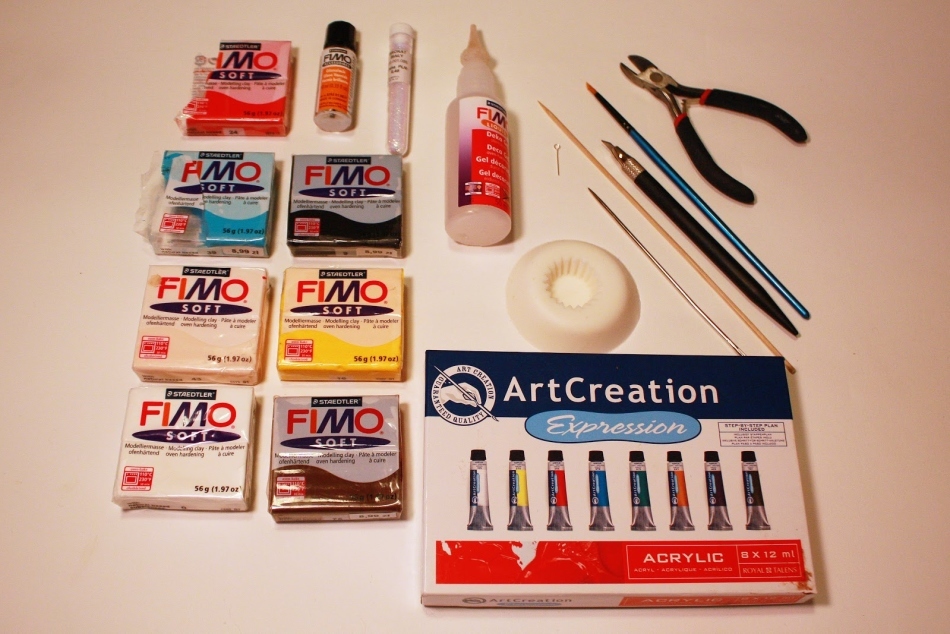 . For working with polymer clay, it is desirable to purchase the Fimo
. For working with polymer clay, it is desirable to purchase the Fimo paint. The basic rules for working with polymer clay are as follows:
- The most basic is the cleanliness. Surface must be clean, like hands. It would be nice to stock up on gloves. And try not to have the villi
on the job site. IMPORTANT: Wet wipes will be very helpful when working. Not only will they keep their hands and tools clean, but they will also help to smooth the unevenness of the material.
- For softening clay , you can use a special tool called plasticizer. Older handymen recommend the Moldmaker brand. A few peas means - this is quite enough for a pack of clay. Alternatively, creams, petrolatum, warming-up procedure
- may be used. There are also cases, when clay and stick to the hands of , especially fresh. Then you can mix it with a harder clay or leave it for a few hours on a white sheet of paper. But if the paint has already gotten into the material, it is hardly possible to do something
- The varnishing of the parts takes place in different ways. On the flat, each side is processed in turn. Round it is better to first string on the toothpick, which, in turn, must be inserted into the clay. You can also dunk the parts in a varnish or apply it with a synthetic brush
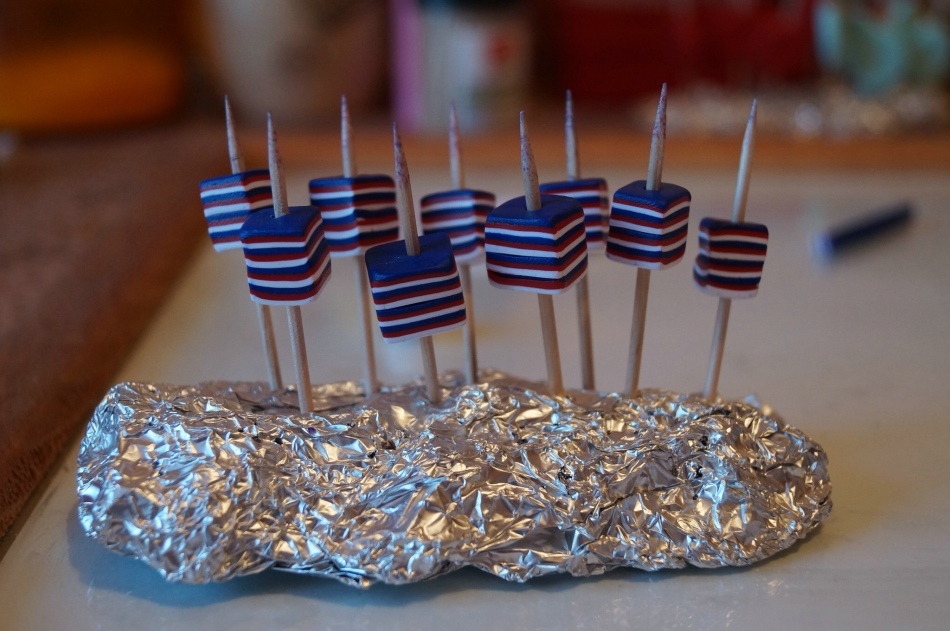 This is how the polymer clay pieces are located on toothpicks for varnishing and drying
This is how the polymer clay pieces are located on toothpicks for varnishing and drying - . Whatever clay is chosen, it must be properly mashed before use, the material becomes plastic, soft and suitable for comfortable molding.
IMPORTANT: Do not ignore this step, otherwise there will be air bubbles in the material, which are converted into bumps when the clay is heated.
- Stock up with a special baked gel - for example, such as FIMO liquid. Sometimes you need to glue a pin to the part - in this case, the hole for it needs to be done a little more, given the
- glue. Keep sausages from clay in a film or a well-closed sachet. Otherwise, they will not dry out, but they will lose plasticity, they will become fragile. This is explained by the evaporation of the plasticizer. It's even better to put the blanks in the refrigerator
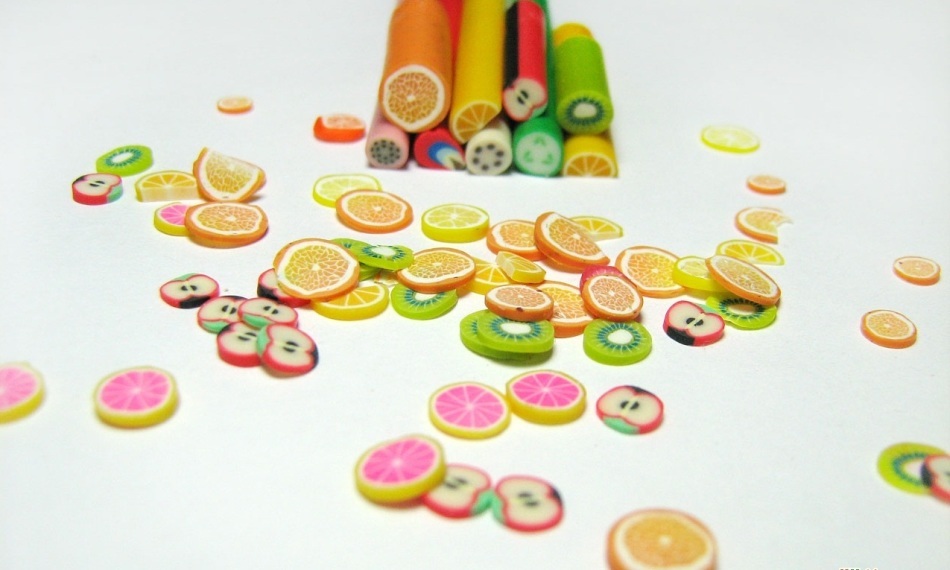 Polymer clay make sausages, which are important to know how to properly store
Polymer clay make sausages, which are important to know how to properly store - . At what stage do you need to grind? After the parts are baked, but before coating with varnish. It is recommended after grinding to wipe the parts with a linen towel - so they become velvety
IMPORTANT: Do not think that the varnish will hide the defects of the material. As a rule, he only emphasizes them. Therefore, it is worth taking time to polish.
How to bake clay crafts?
On the baking process should be discussed separately, but this does not mean that it is somehow too sophisticated and requires a special oven.
This is not ceramics - here is quite an ordinary oven , because the temperature at which many types of polymer clay solidify equals the to just 110-130 degrees.
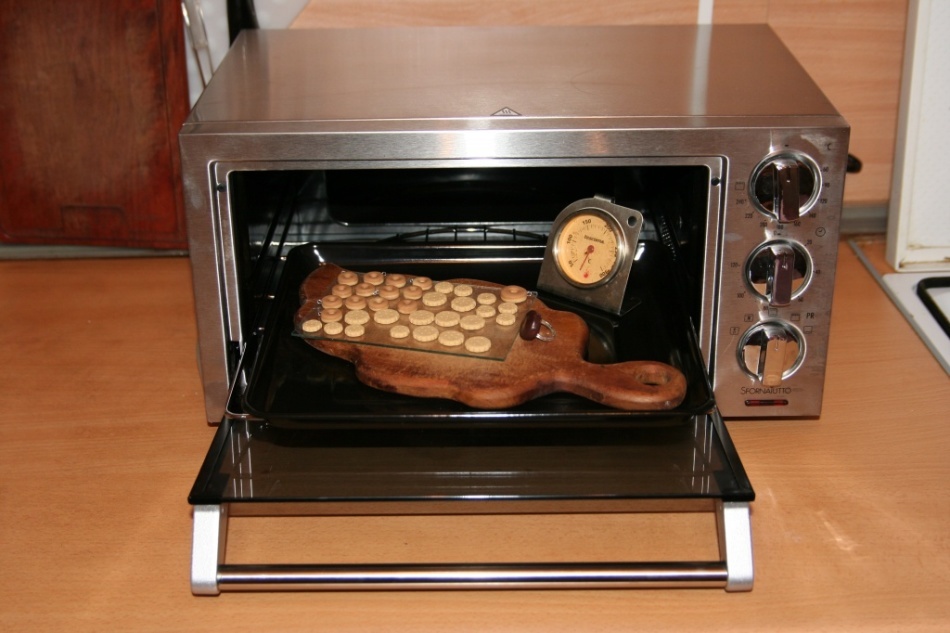 This is how a special oven for baking products from polymer clay
This is how a special oven for baking products from polymer clay - looks like What should bake handicrafts? No way on dishes that are used for food
- It is better to adapt a special baking sheet, which in turn is folded with accordion paper
- . Much depends on what is baked. So, the beads will feel great, strung on a toothpick stuck in the foil. Flat parts are recommended to be placed on glass or ceramic tiles
- It is possible to place glass in the sleeve for baking, and then to get an article on the street - this is if you are in doubt about the toxicity of
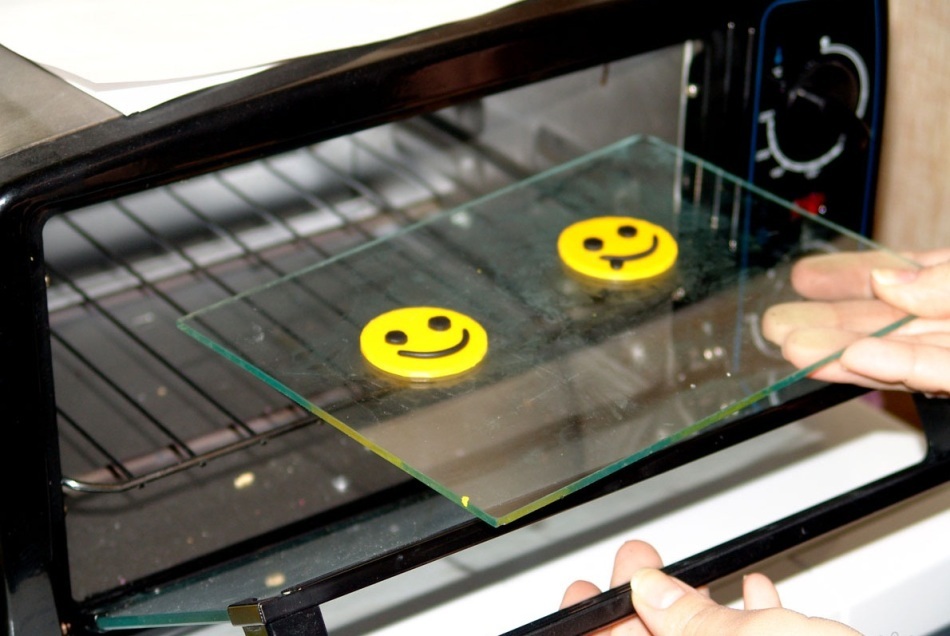 . Preforms made of polymer clay are well baked on
. Preforms made of polymer clay are well baked on glass. In general, not to stand outtoxic substances , it is necessary to adhere to the temperatures indicated on the clay package. And even at the same time it is necessary to work when drawing. After each work, the stove must be washed thoroughly.
IMPORTANT: If there is a smell, and the article itself has turned black and even charred, stop baking immediately, and ventilate the room well.
The needlewomen strongly recommend that beginners make a trial baking of , directing only a small part of the billet to the oven.
If the product becomes dense after the treatment in the plate, the thin parts are able to bend, and with subsequent drilling, a long chip is formed - everything is in order, you are on the right track.
Crafts of polymer clay for beginners step by step: master class
Beginners need to first of all learn master classes on making sausages from polymer clay .Having such sausages, in the future you can create spectacular details for different products.
 Snowflakes, flowers, fern leaves - all of this can be easily made from polymer clay
Snowflakes, flowers, fern leaves - all of this can be easily made from polymer clay So, let's try to make the the simplest sausage-strawberry , which even a newcomer can do:
- So, you need pink, red and white clay. From the white , blend the slightly elongated triangle , and from the pink the layer about a millimeter thick
IMPORTANT: Before the sheet is rolled, the clay should be well kneaded.
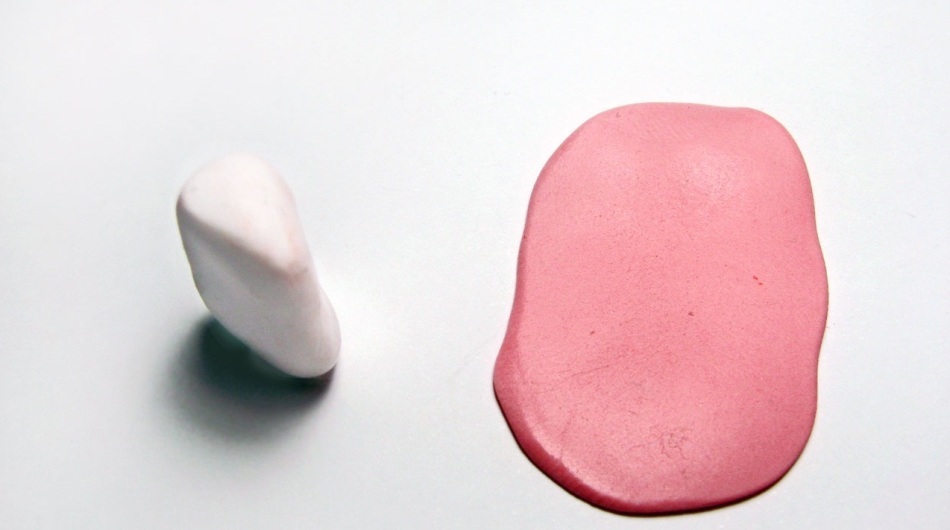 It is necessary to make a triangle and a layer of polymer clay
It is necessary to make a triangle and a layer of polymer clay - More from white clay it is necessary to make sausages. Sausages will also be needed from the red .Then they need to be interconnected
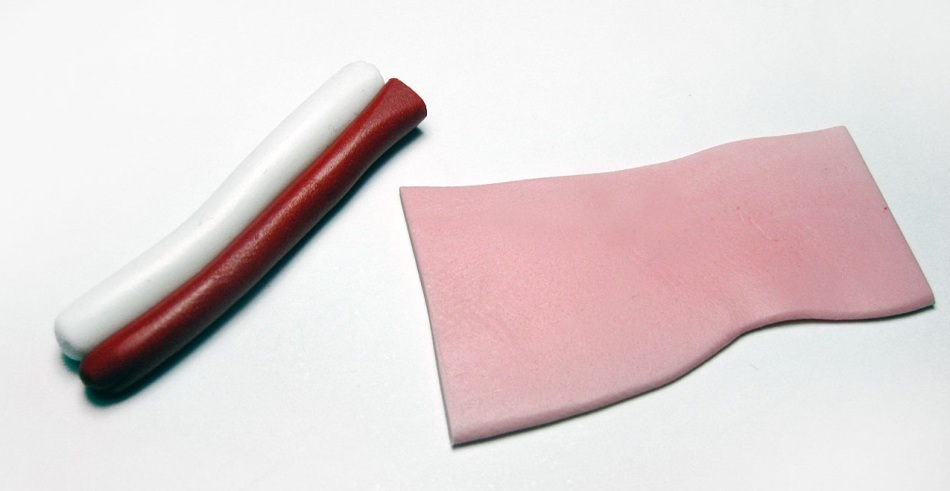 Need to roll sausages of red and white polymer clay
Need to roll sausages of red and white polymer clay - Gently wrap connected red and white sausages with a pink layer
 Sausages made of polymer clay wrapped with
Sausages made of polymer clay wrapped with - The resulting red-white-pink sausage should be pulled as carefully as possible. Approximately until it reaches a length of 12 or 13 centimeters. When pulling the product in no case should lose its original form
- And after that sausage it is possible to cut in equal pieces
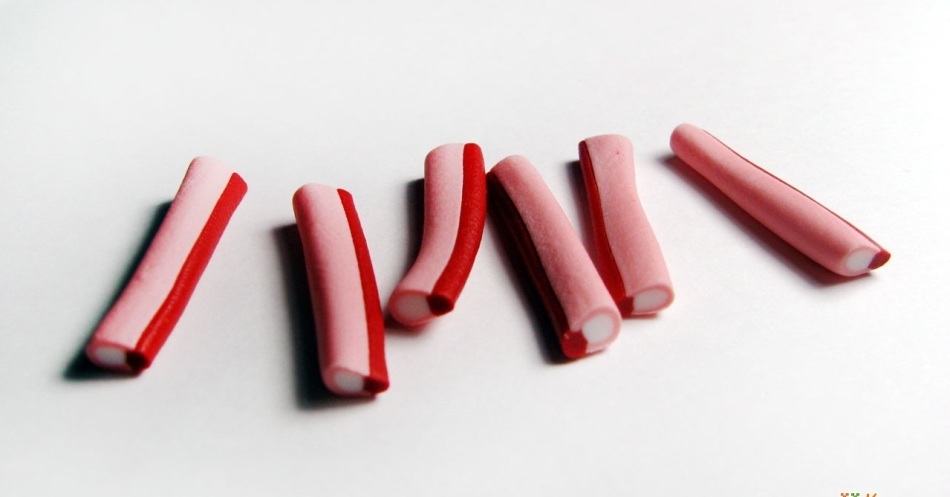 Here such should be the sausages from polymer clay
Here such should be the sausages from polymer clay - Now from the scattered sausages the strawberry is formed. It is not difficult to form it: a white sausage turns into a pink layer and clings to sausages of red and white clay in a circle.
IMPORTANT: Do not glue the entire core, leaving the bottom untouched, as shown in the photo.
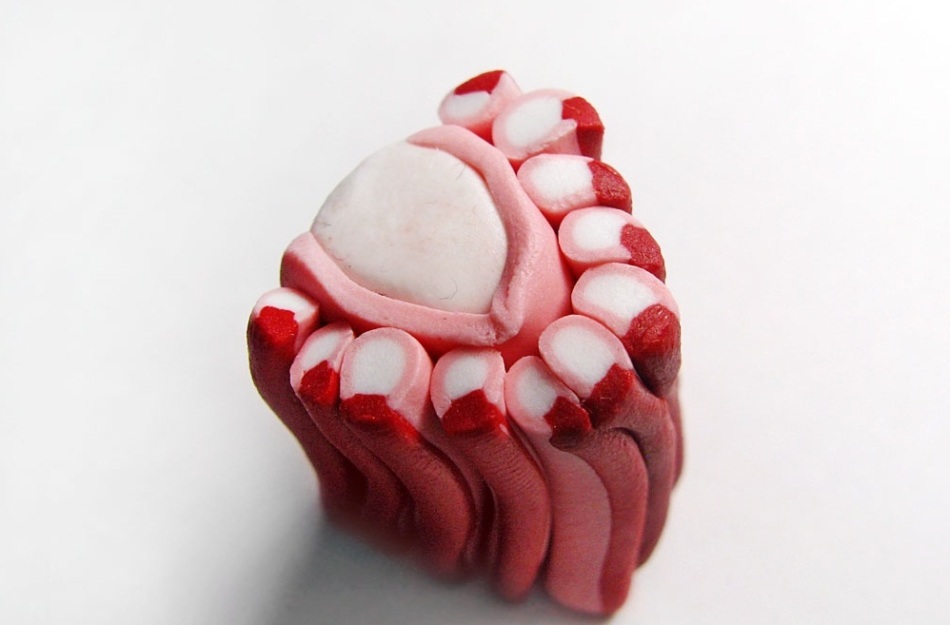 This is how the sausages from polymer clay are combined to form the strawberry
This is how the sausages from polymer clay are combined to form the strawberry - Now the core once again turns around , but this time the layer of red polymer clay
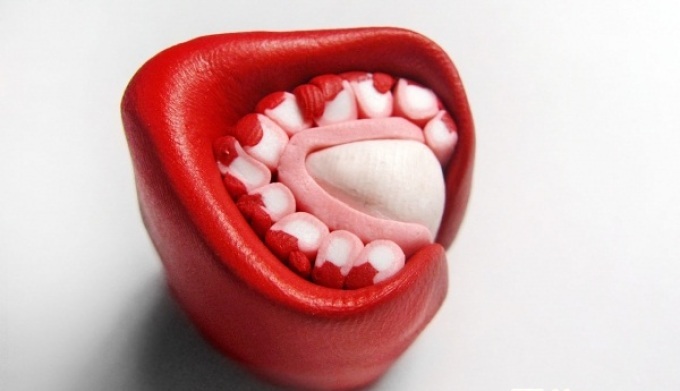 The future berry of polymer clay turns into a red layer
The future berry of polymer clay turns into a red layer - At this stage the sausage needs to be stretched to the size that is convenient. Please note that for beads it should be thick and short, and for toy pieces - thin and long
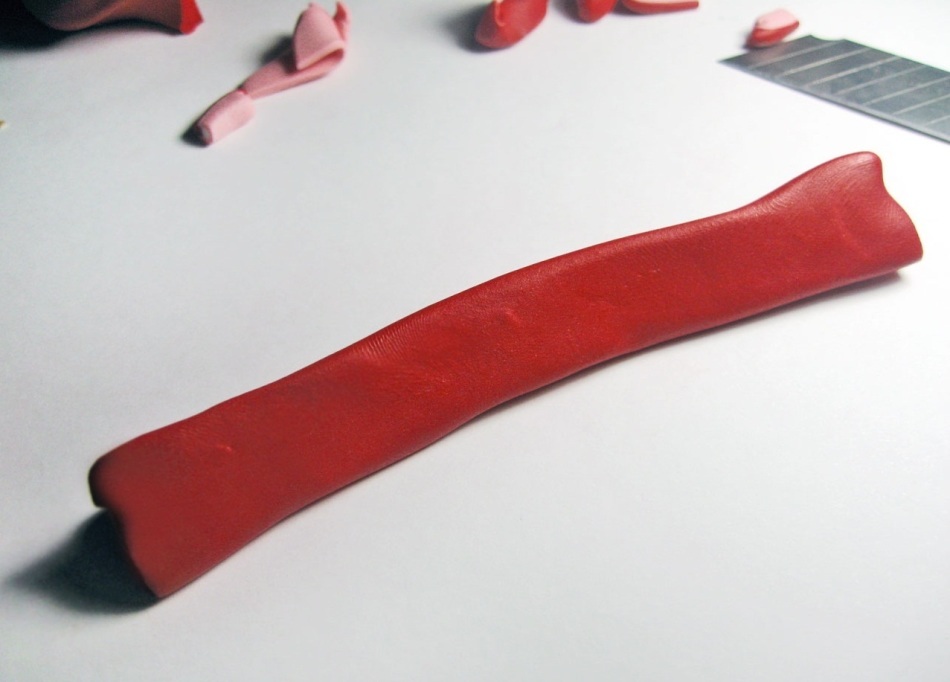 Polymer clay sausage stretched
Polymer clay sausage stretched 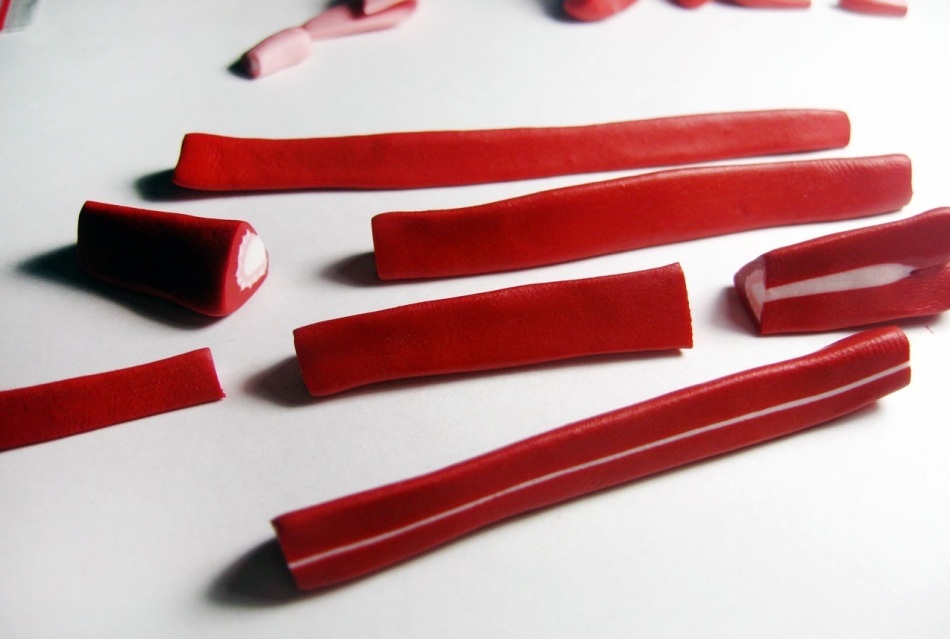 For convenience, first cut the sausage from polymer clay and then draw
For convenience, first cut the sausage from polymer clay and then draw - And here's the final stage - baking !!Do this for about half an hour, after which the needs to be cooled and cut into strawberries
- . When properly made, they should be easily cut, resembling the structure of a rather dense rubber
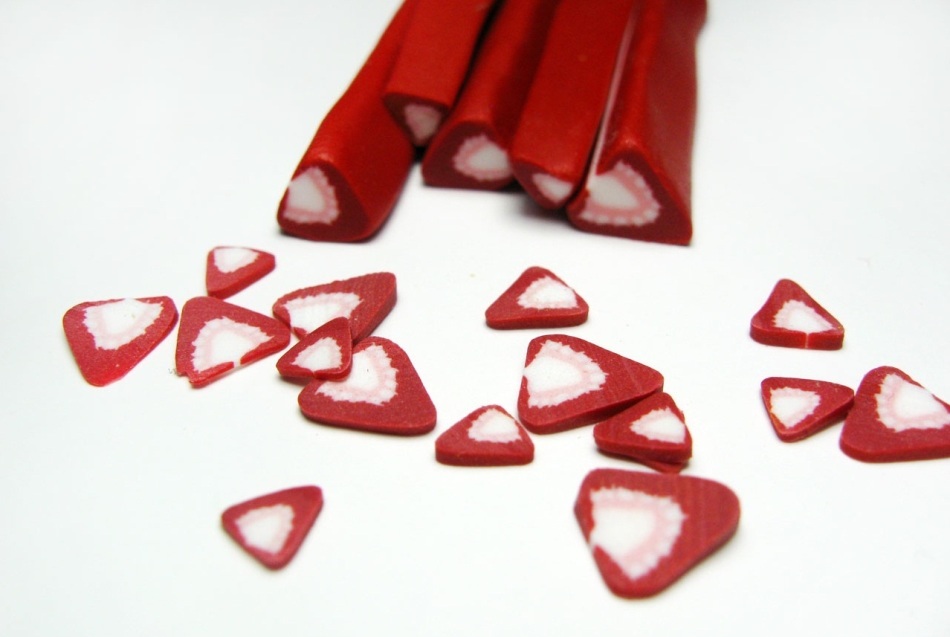 . Now the sausages can be turned into strawberries from polymer clay
. Now the sausages can be turned into strawberries from polymer clay . The described master class is designed forSimplified manufacture of sausages-strawberries. If you want something more naturalistic, then can use the paste machine .
It allows you to achieve smooth color transitions. As an analogy, take an acrylic rolling pin, only with it you have to poke around longer.
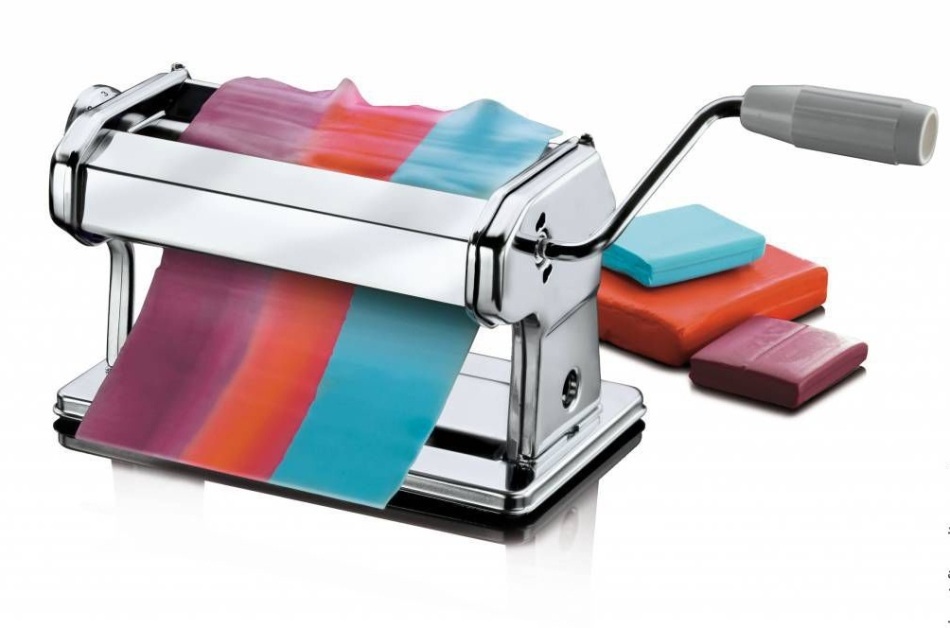 Paste machine for polymer clay allows to achieve smooth transitions in shades
Paste machine for polymer clay allows to achieve smooth transitions in shades 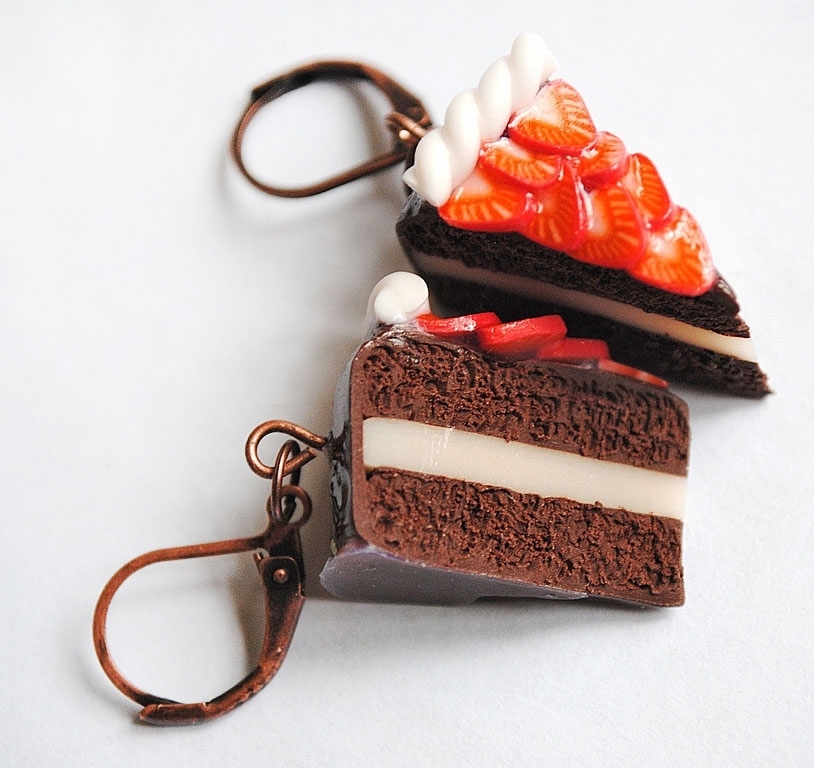 Puffs made of polymer clay can be used for key rings
Puffs made of polymer clay can be used for key rings 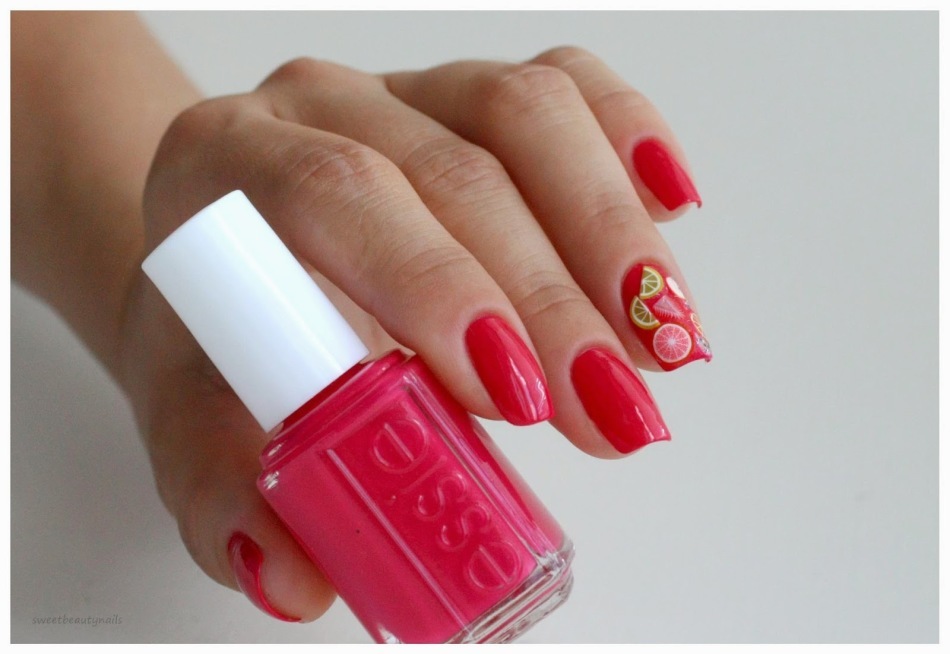 Fruit from sausages made of polymer clay can be used in manicure
Fruit from sausages made of polymer clay can be used in manicure Beginners can also practice on buttons - they are very easy to do, and the thingit turns out beautiful and useful. So, for the simplest recipe for you will need :
- Actually, polymer clay
- Acrylic paint with which you can decorate
- Emery
- Sleeve in which you make baking
- Any button of vintage type
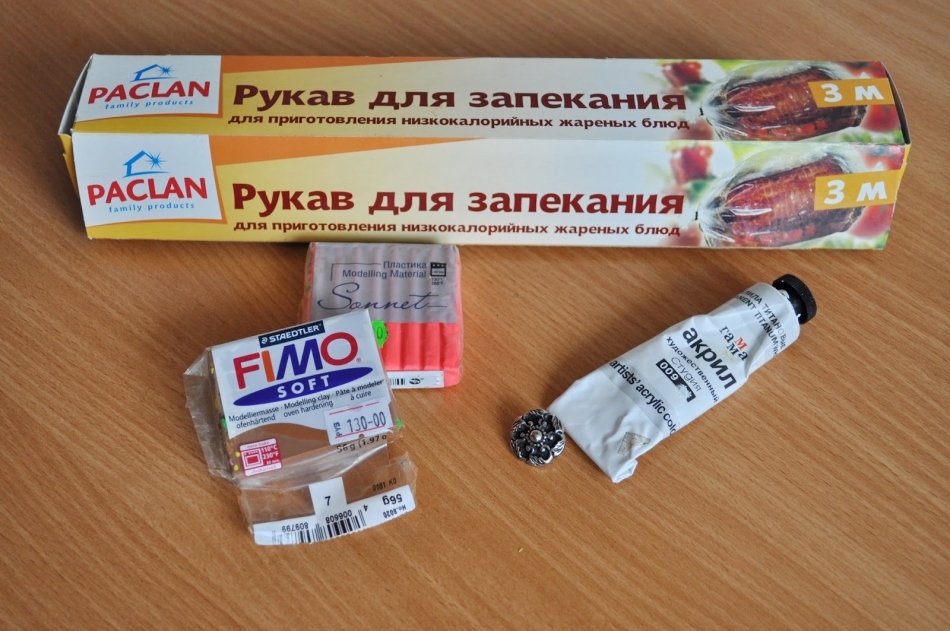 Here's what you need to make a buttonfrom polymer clay
Here's what you need to make a buttonfrom polymer clay - So, first you just need to roll out of polymer clay balls .Choose colors on your own. To the balls attach the button
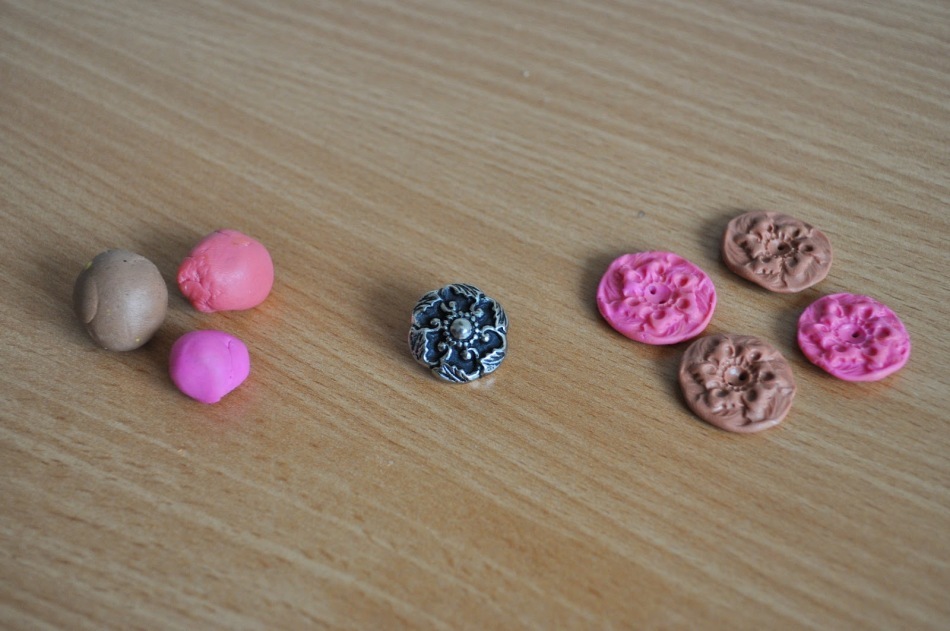 From the polymer clay roll the balls
From the polymer clay roll the balls - Now with the thick needle make holes .Such blanks can immediately be packed in a sleeve and baked at a temperature of 110 degrees
IMPORTANT: Better do not use a baking tray, as it will not always turn out to be fully washed, like an oven. And even in this case, leave the oven door slightly open.
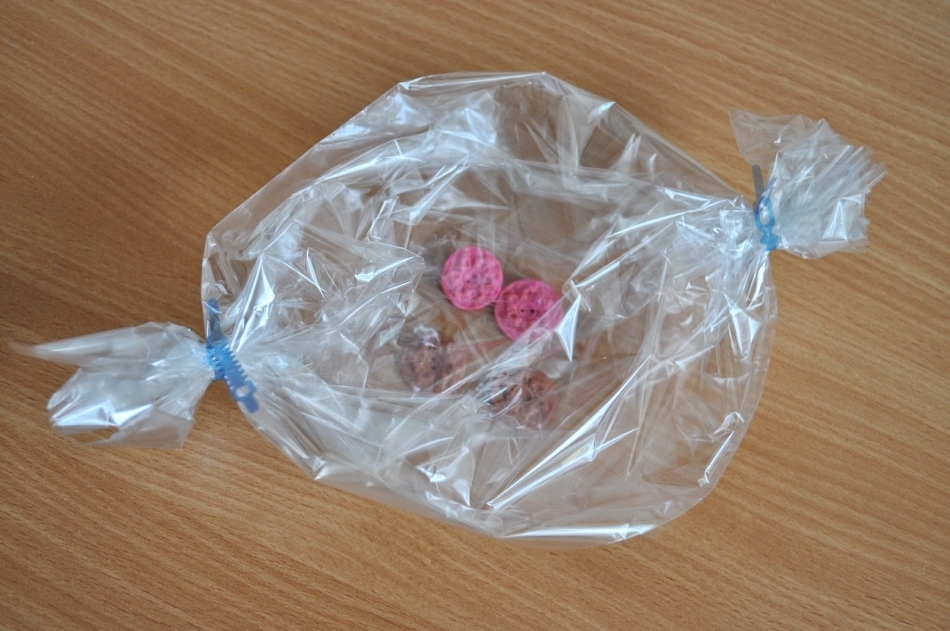 Billets made of polymer clay are baked
Billets made of polymer clay are baked - Sanded burrs are processed with .You can carefully trim the edges of the
- Now you can bring the last strokes, processing the product with paint or varnish
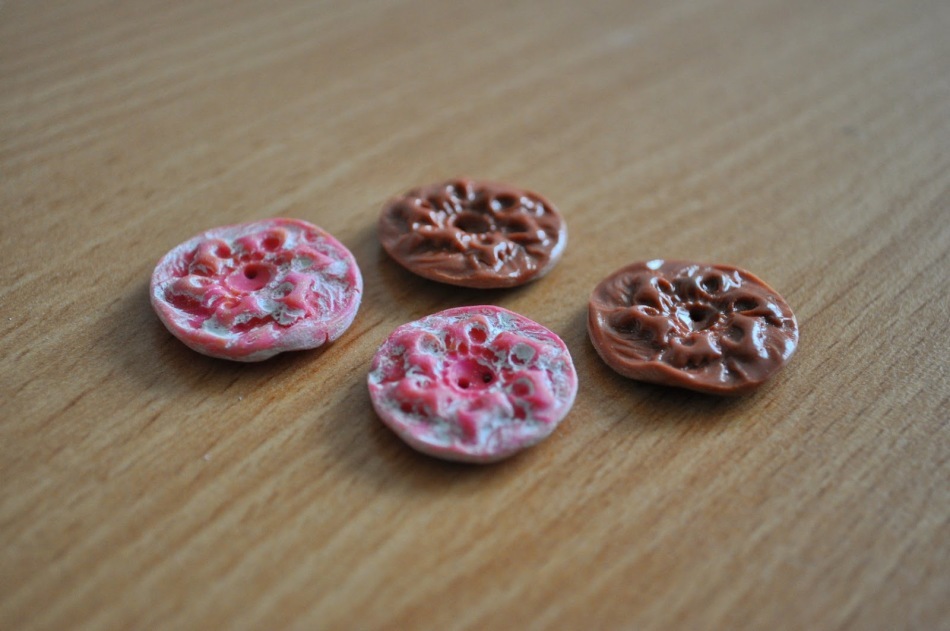 The buttons made of polymer clay are covered with varnish or acrylic paint
The buttons made of polymer clay are covered with varnish or acrylic paint And what if you want to make such a trinket but do not have a vintage button at hand? It does not matter: can create an odd job in a different way , and it's easy too!
- Roll the polymer clay into the layer thinner. Attach to the layer a piece of lace , which will probably be found in any house. But before applying, be sure to lightly sprinkle the clay with water
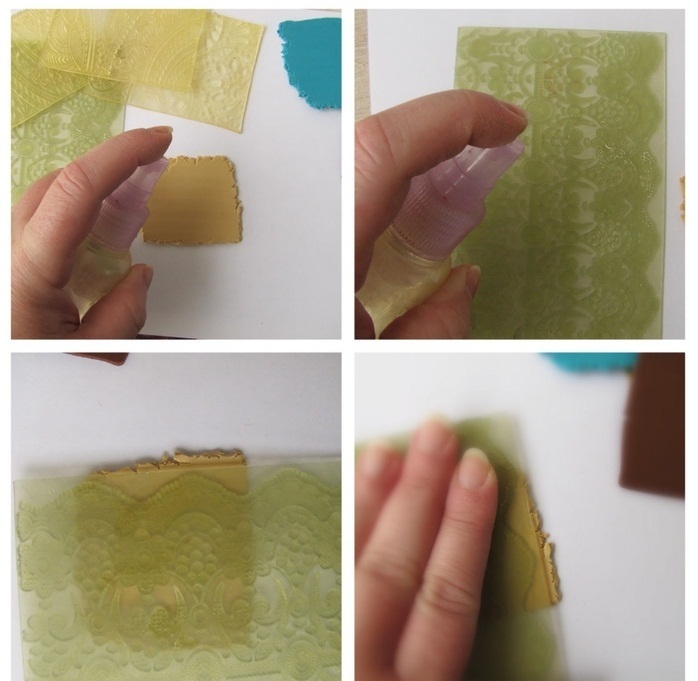 Polymer clay is rolled into a layer, the lace
Polymer clay is rolled into a layer, the lace  is applied to it. As a result, the
is applied to it. As a result, the - is obtained from the polymer clay. now cover the workpiece with polyethylene. Without it, the cut out will turn out sloppy
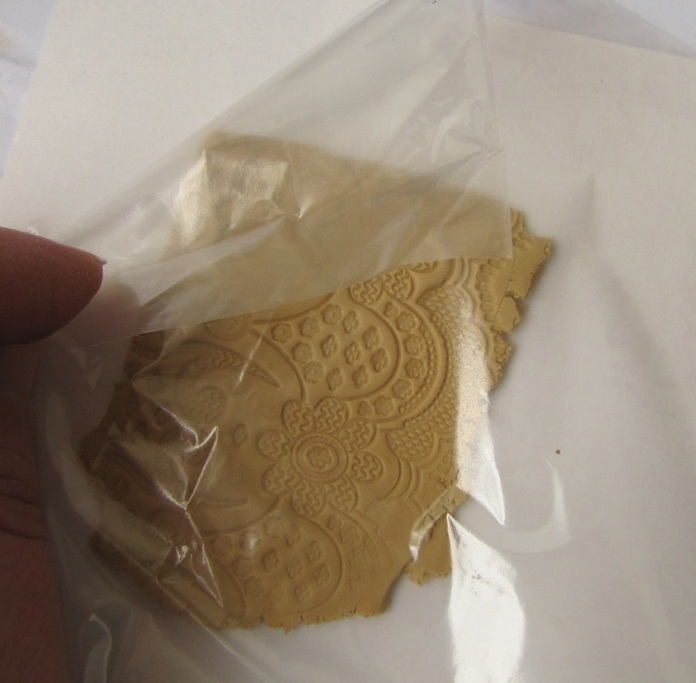 . The polymer clay blanket is covered with polyethylene
. The polymer clay blanket is covered with polyethylene - The mold must be pressed on the bed. The mold can be absolutely any shape
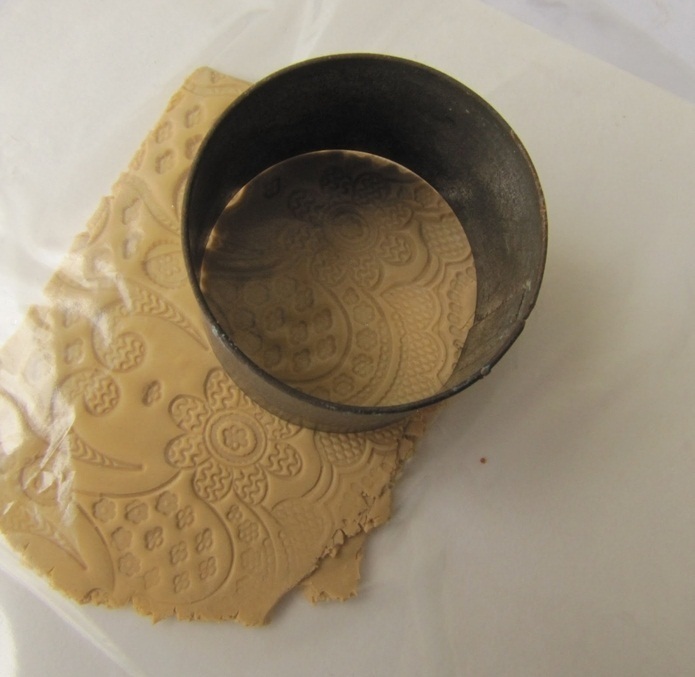 The mold should be pressed on the polymer clay
The mold should be pressed on the polymer clay - By the resulting contours it's easy to you can carefully cut future button
 On these contours you can cut out the desired piece of polymer clay
On these contours you can cut out the desired piece of polymer clay 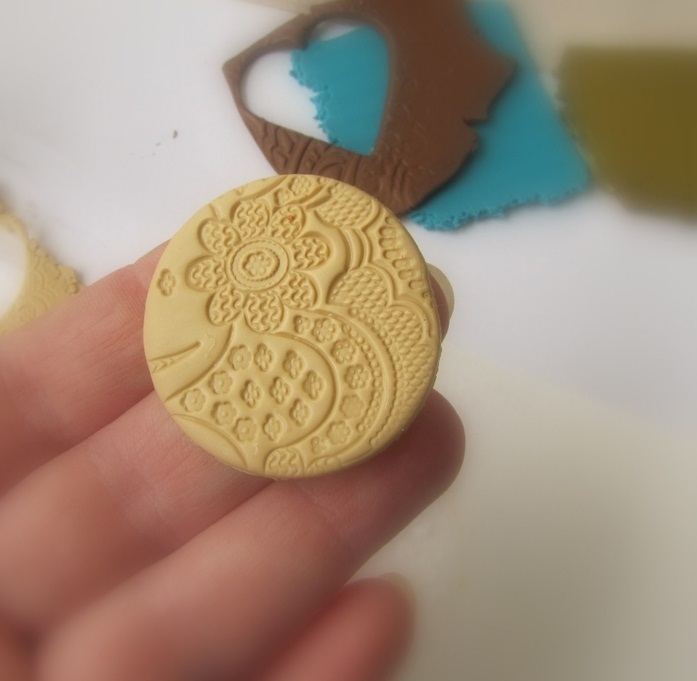 Here is a cut out button made of polymer clay
Here is a cut out button made of polymer clay - toothpicks are made with
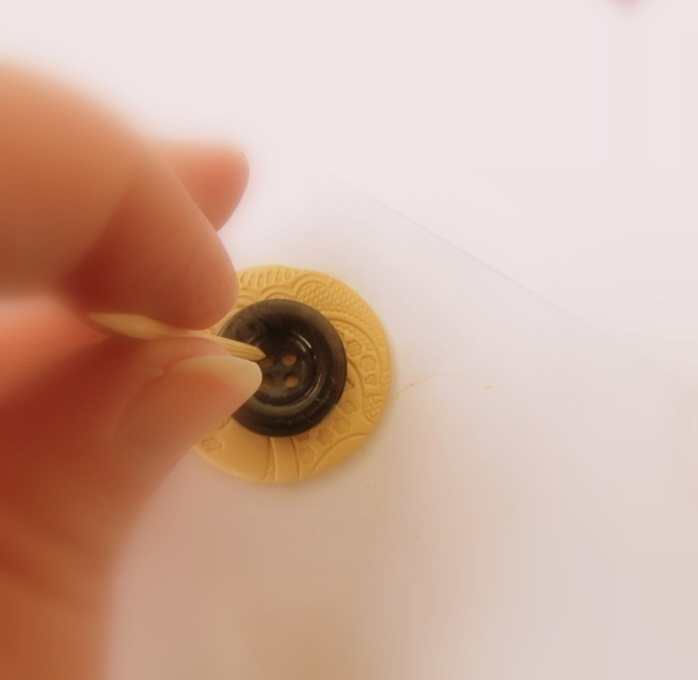 holes. Toothpicks are made in polymer clay
holes. Toothpicks are made in polymer clay - . billets are baked, cools and they can be covered with acrylic paint
IMPORTANT: Cool the thing in the oven.
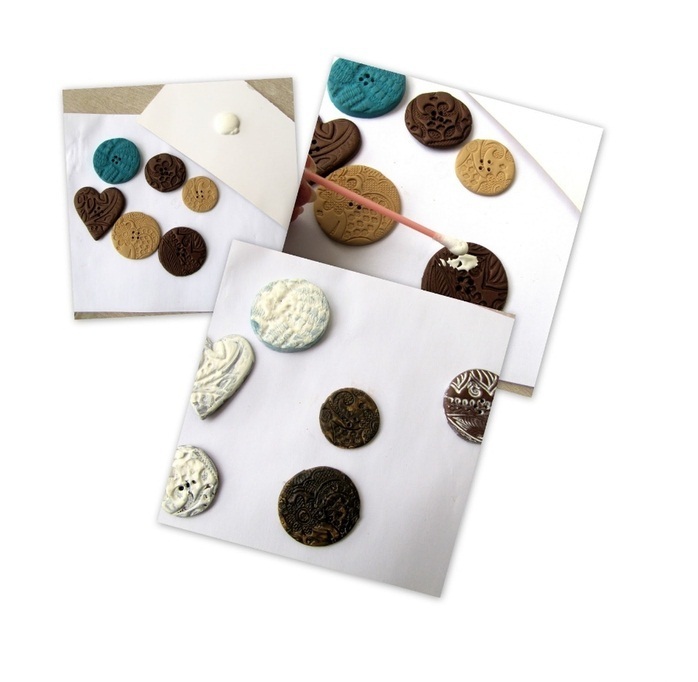 Polymer clay pads covered with acrylic paint
Polymer clay pads covered with acrylic paint 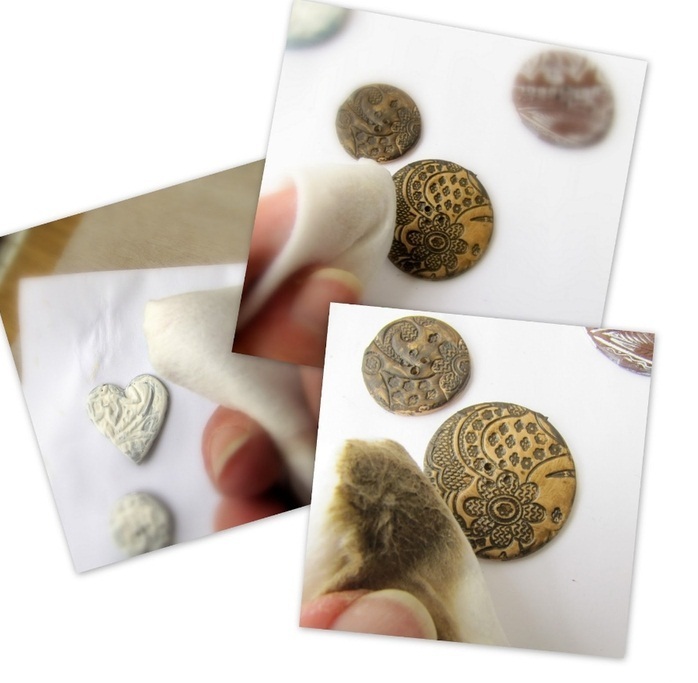 Surplus paint left on the polymer clay can be carefully removed with a napkin
Surplus paint left on the polymer clay can be carefully removed with a napkin  These are the clasps made of polymer clay
These are the clasps made of polymer clay Lightweight crafts made of polymer clay
An magnet for needles is an easy and useful craft. will be needed:
- Skalka and surface works
- Molds
- Polymer Clay
- Acrylic paint, brush
- Lace
- Sandpaper
- 2 magnet
- Clay
can get to work:
- clay must be properly mash hands
- Then it rolled
- Using the biscuit mold, the desired contours of the are cut out. The edges are trimmed
- Now the workpiece is pressed into the lace
- You can bake the handmade item in the oven. However, if the polymer clay is purchased with the feature of self-hardening, it's still simpler - you just need to let it freeze
- is used to work on the
- . Now can paint as well as you want. If there is a desire to somehow decorate the magnet - it's time to do it
- The magnet is attached to the back side of the craft. That's it, you can use it! Apply a useful article on the fabric pre-fastened in the frame
 Here is a magnet for needles made of polymer clay
Here is a magnet for needles made of polymer clay IMPORTANT: Do not forget about the second magnet, which is applied from the back of the fabric to the attached to the craft.
The next easy to manufacture and useful piece of polymer clay - cover for cans .The lid will outwardly resemble a weaving from a vine, so any jar will look with her economically and snugly. It is necessary to stock up with such things:
- Any most ordinary cover from the can
- Polymer clay of any shades. But to recreate the effect of weaving is best beige, red, yellow, green, brown and dark blue
- If there is molds - a special mold for creating 3D shapes - it will be very handy
- Glue PVA or liquid plastic
- Orange and brown pastel
- Green, yellow, white, red acrylic paint
- Varnish, also acrylic
- Device for rolling polymer clay - acrylic rolling pin, glass rolling pin, for lack of - ordinary can
- A special special machine for the processing of polymeric raw materials, called extruder
- Brush for the application of paint. At the same time, choose a brush thinner
- A stick is sharper or a toothpick
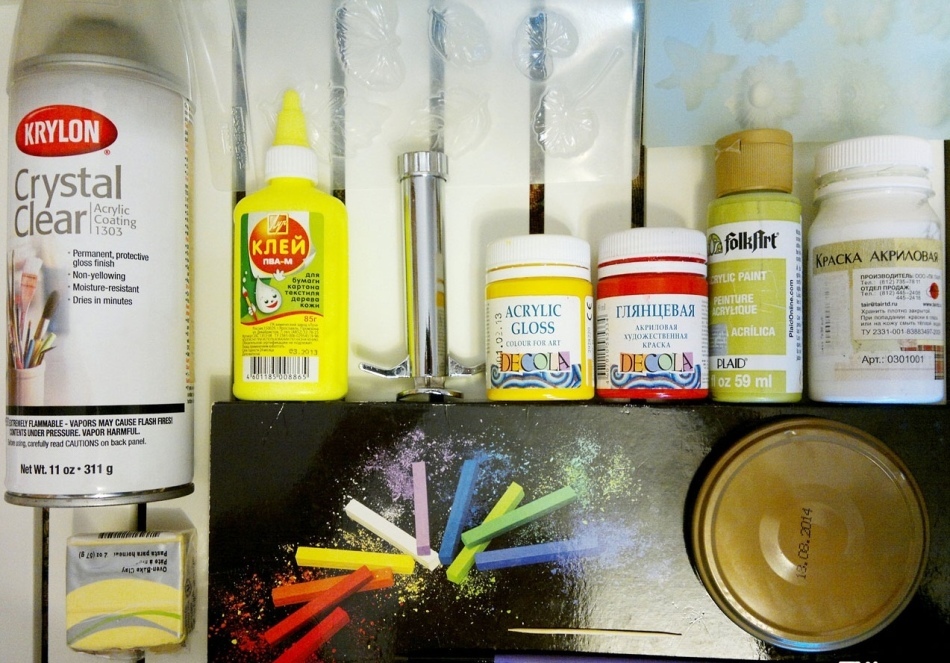 That's what you need to stock up for making a clamp of polymer clay
That's what you need to stock up for making a clamp of polymer clay - First you take a piece of brown clay and rolls to the state of .Please note that it should be no less than the size of the
- source cap. The original cover is smeared with with liquid plastic or PVA
glue IMPORTANT: It is recommended that if possible, sand the lid with a large amount of sandpaper.
- Now the clay should be put on the lid. It must cover the entire surface of the cover, but it should not prevent it from closing. It will be necessary to make immediately cuts - so air bubbles will be released. Alternatively, you can puncture the clay - then the air will come out in the baking process, otherwise the clay will simply rise
- It's time for to wring the polymer clay into the sausage, then immersing it in an extruder. This must be done with brown and beige clay. The thickness can be any
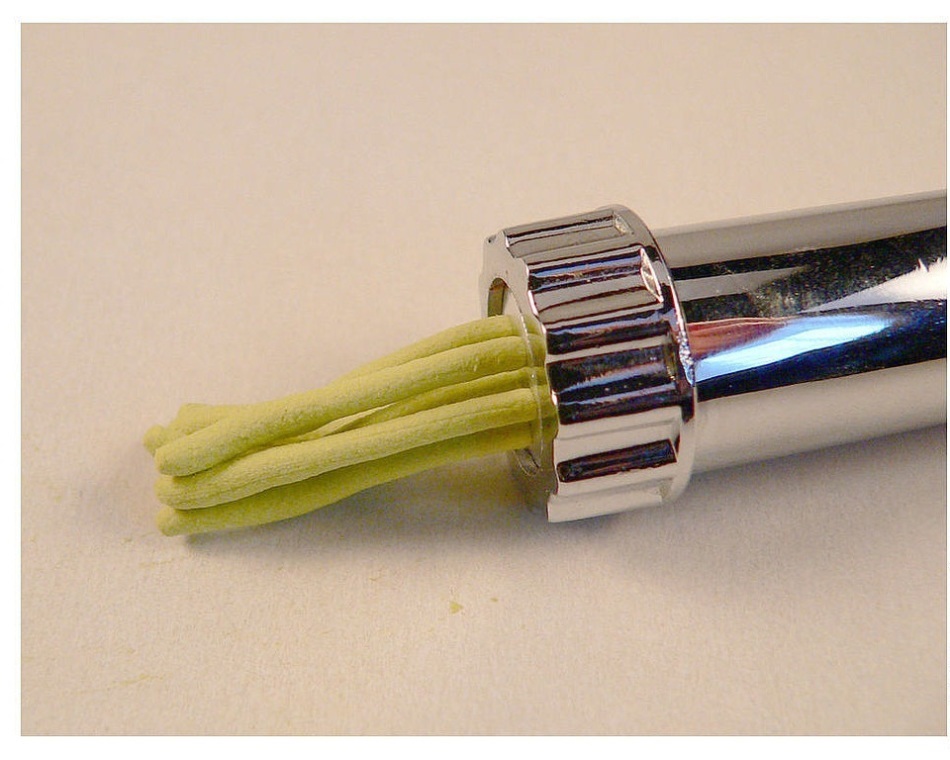 The extruder for polymer clay works as follows
The extruder for polymer clay works as follows IMPORTANT: If there is no extruder, just gently knead the sausage - so that the shades do not mix. After that, you need to cut off pieces from it, gradually rolling them into thin threads.
- Now you need to twist the strings .First, take a bundle of four and lay them horizontally on the lid. The ends must extend beyond the cover. Then take four more threads and put them on top of the previous ones, just perpendicular to them.
- Spread the threads so that their ends part from each other. according to the principle of the
- . Take another pair of polymer clay yarns and place them in the center of the improvised web. Begin the braiding according to the chess principle - threading the leading threads over the others, then under them. If you have ever woven wreaths or baskets, then you must cope very quickly.
IMPORTANT: It is recommended to use a toothpick so that the beams are better raised and do not get tangled where you do not need them.
- You need to weave the spider web to the edges of the lid. If the threads end - they just stick to the old ones. After that, the weaving is carefully removed from the lid, transferred to the
- paper. The cover is covered with a PVA or liquid plastic .In the first case, it is necessary to act quickly - before the
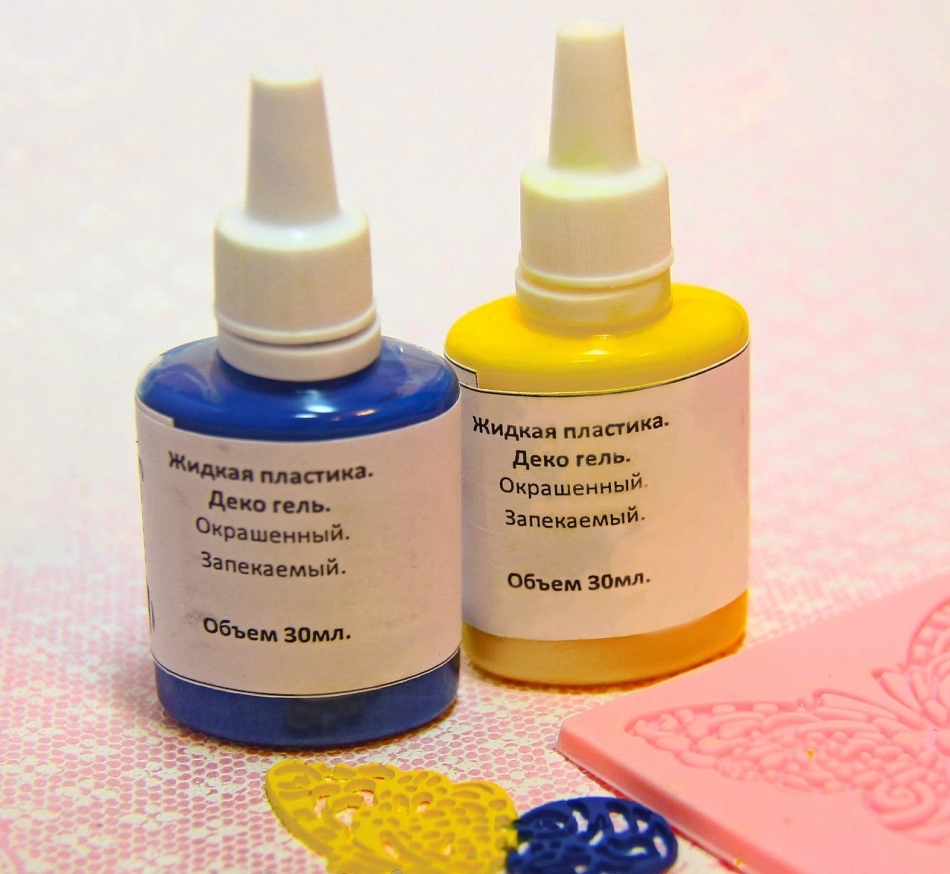 glue dries. Liquid plastic is very convenient for making artifacts from polymeric clay
glue dries. Liquid plastic is very convenient for making artifacts from polymeric clay - . The web of polymer clay is returned to the lid again. And now needs to finish this weaving with edging .It is made of six stripes intertwined with a braid
 This is the result of weaving from polymer clay to which the edging
This is the result of weaving from polymer clay to which the edging - is needed. Now can decorate the cover to your taste - for example, to create from polymer clay flowers or berries, not forgetting to coat them with varnish
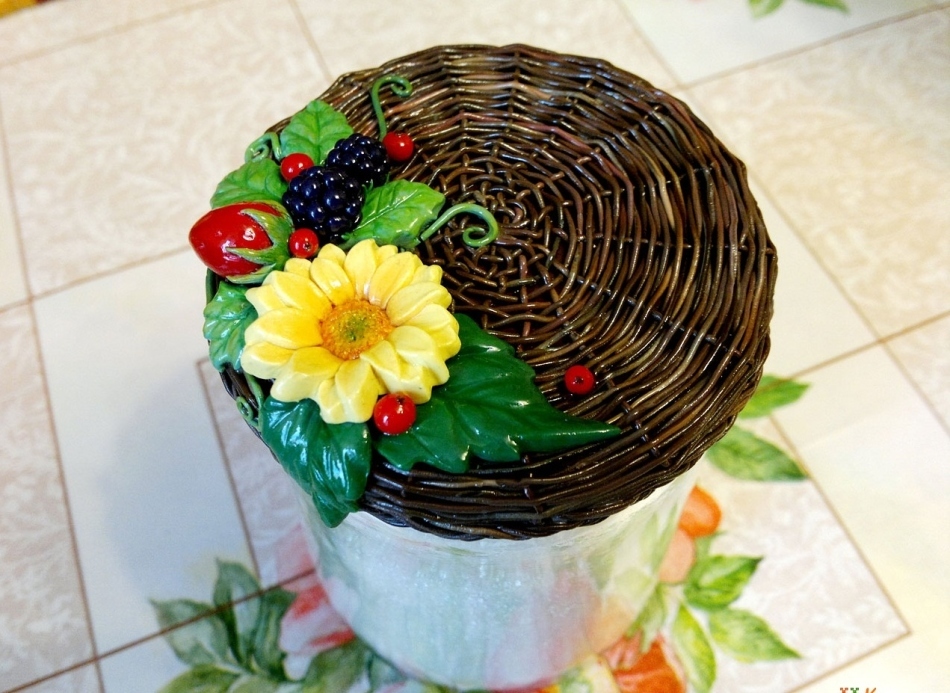 This is the result of a lid for a jar of polymer clay
This is the result of a lid for a jar of polymer clay Lovers of weaving and just useful trifles will certainly have to taste a miniature casket for rings. Do it in the form of a basket
You will need:
- Clay
- Wire , whose thickness is approximately 0,8-1 millimeter
- Stationery knife
- Capacity , which resembles a basket. Very good for this purpose jars from under the cream
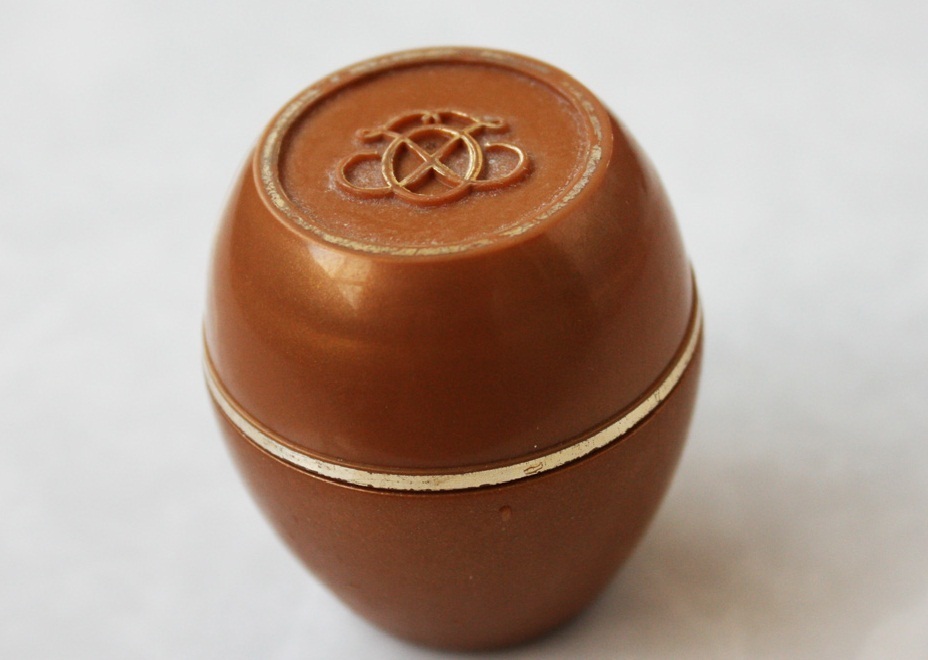 Here is a jar of cream is best for making a basket of polymer clay
Here is a jar of cream is best for making a basket of polymer clay So, get down to work:
- Roll out the polymer clay to the state of the sausage .Its thickness should be about 1.5-2 millimeters. It is best to use an extruder, but it is not critical if it is not at hand
- This sausage should be cut into pieces of 3 cm in length
IMPORTANT: Make sure that the number of pieces is odd.
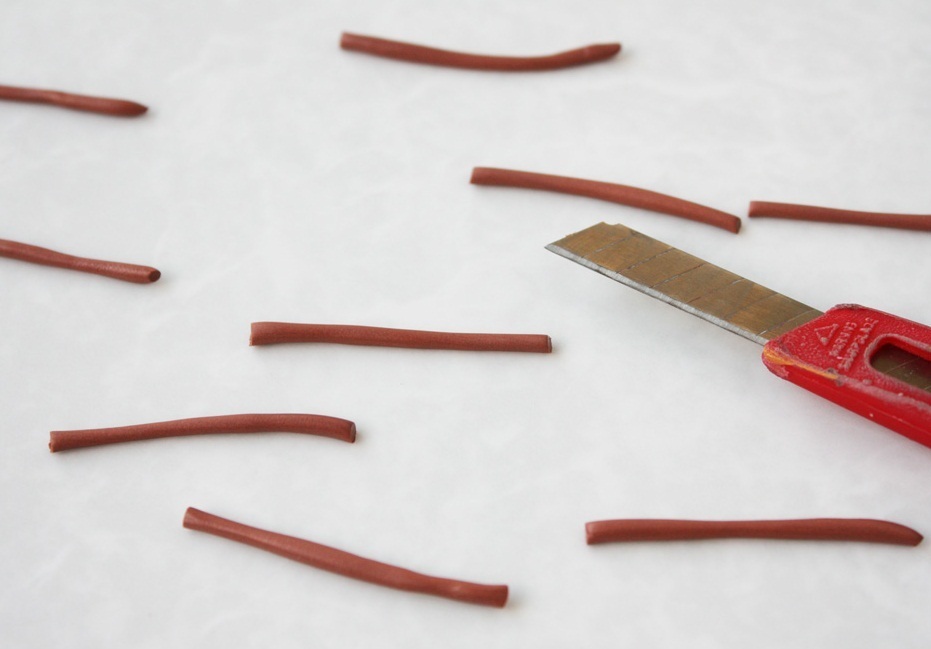 Pieces of polymer clay, from which the basket
Pieces of polymer clay, from which the basket - will be formed. The container itself should be turned over. After that, can be pasted on it with polymer clay cuttings
 Glueing pieces of polymer clay
Glueing pieces of polymer clay - Gently it is necessary to cut off excess parts of pieces so that they are the same length
 The excess parts of polymer clay need to be cut
The excess parts of polymer clay need to be cut - Now the clay is made of .It must be attached to the bottom of the tank. For a better effect, it will be nice to iron the toothpick with this circle.
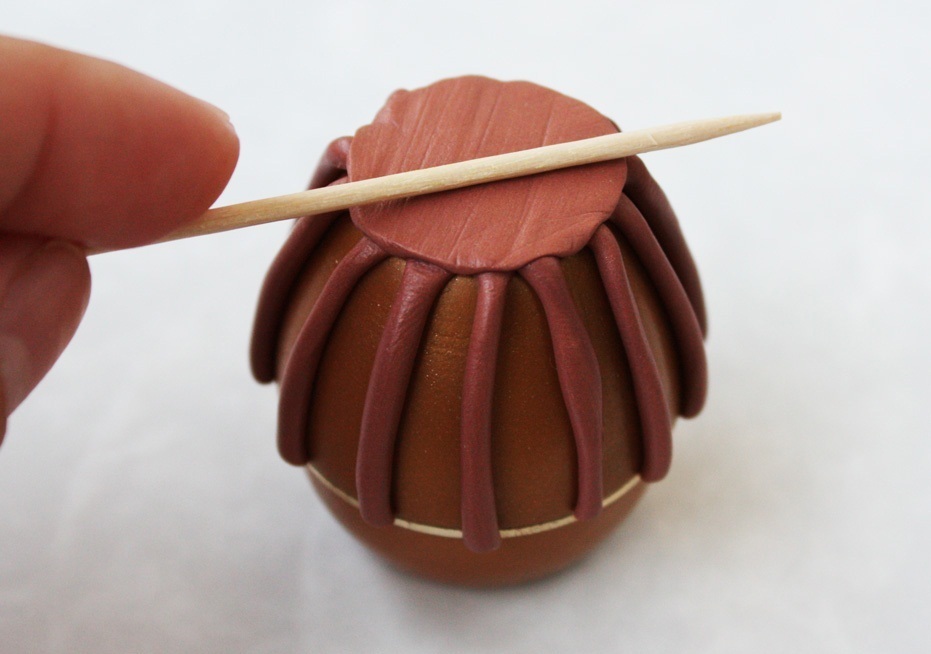 A circle of polymer clay that is attached to the bottom, it is desirable to iron the toothpick
A circle of polymer clay that is attached to the bottom, it is desirable to iron the toothpick - . The jar is placed in this form in the oven .The temperature depends on the type of clay, but the time is enough for 5 or 8 minutes. After baking, the jar falls into cold water, cools and is freed from polymer clay.
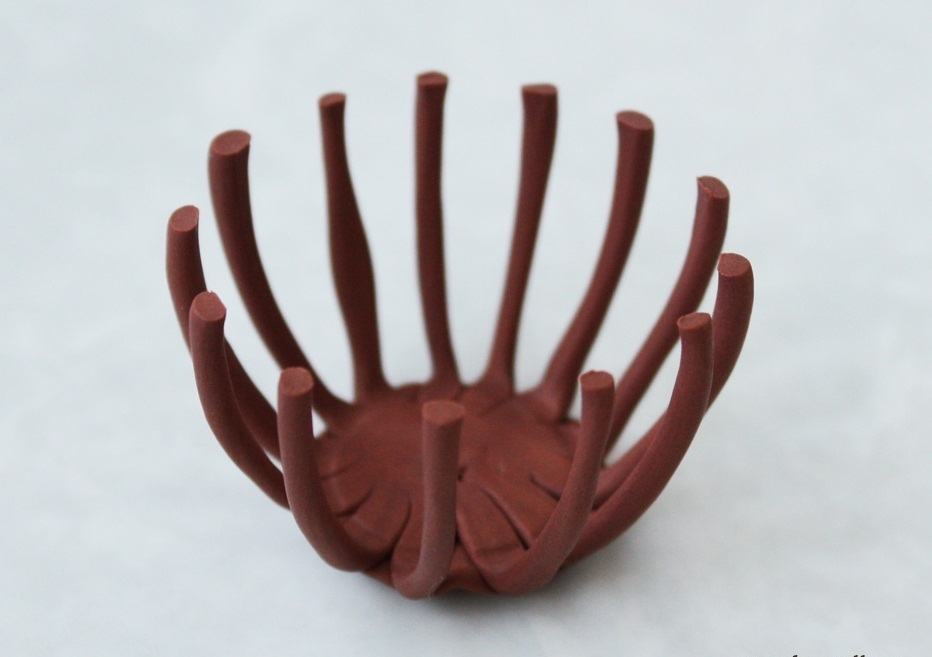 . The polymer clay frame is ready.
. The polymer clay frame is ready. - Roll the sausage of the same length as you can make. However, it will be possible to connect sausages during the weaving process, which is easier to do with the extruder.
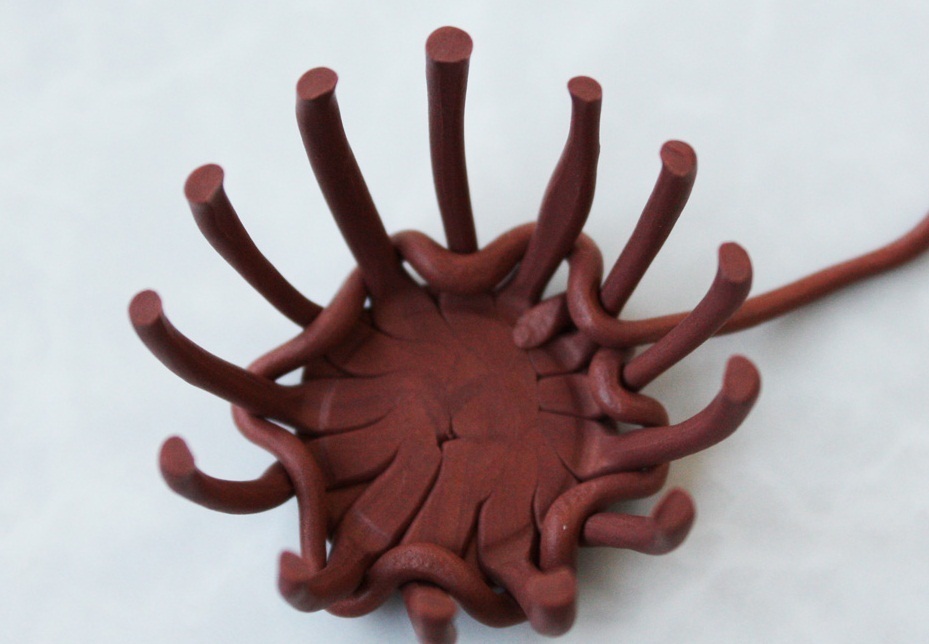 Weaving the basket of polymer clay
Weaving the basket of polymer clay IMPORTANT: After weaving, the basket should not be adjusted laterally, otherwise the natural weaving effect will disappear.
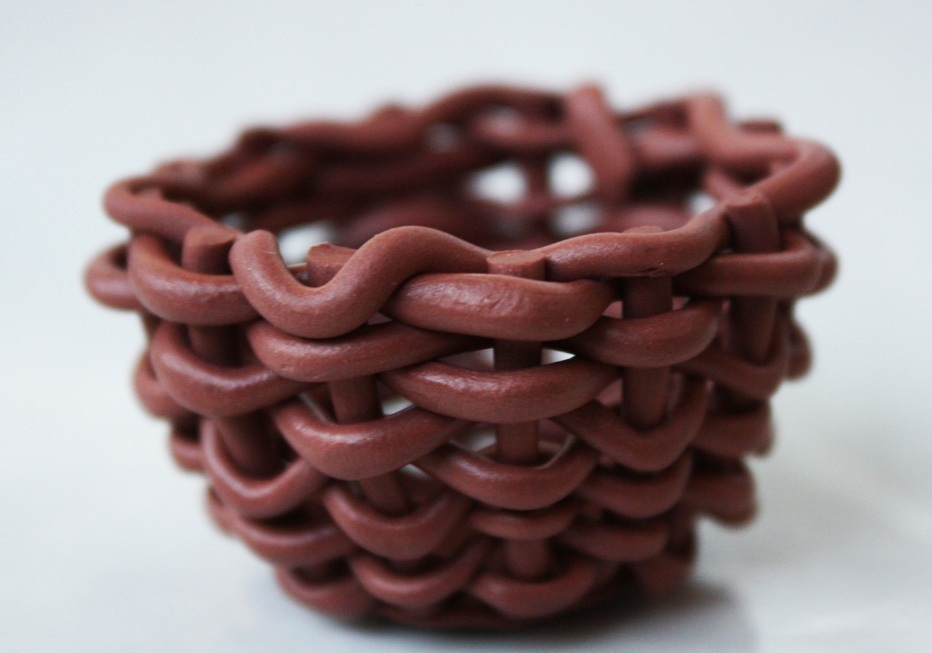 At the end of the weaving is obtained such a basket of polymer clay
At the end of the weaving is obtained such a basket of polymer clay - If you want to give the basis of the basket completeness, you can weave pigtail from two parts and paste it on top. And on the bottom from the inside, you can attach a circle of clay - so the bottom will become more accurate
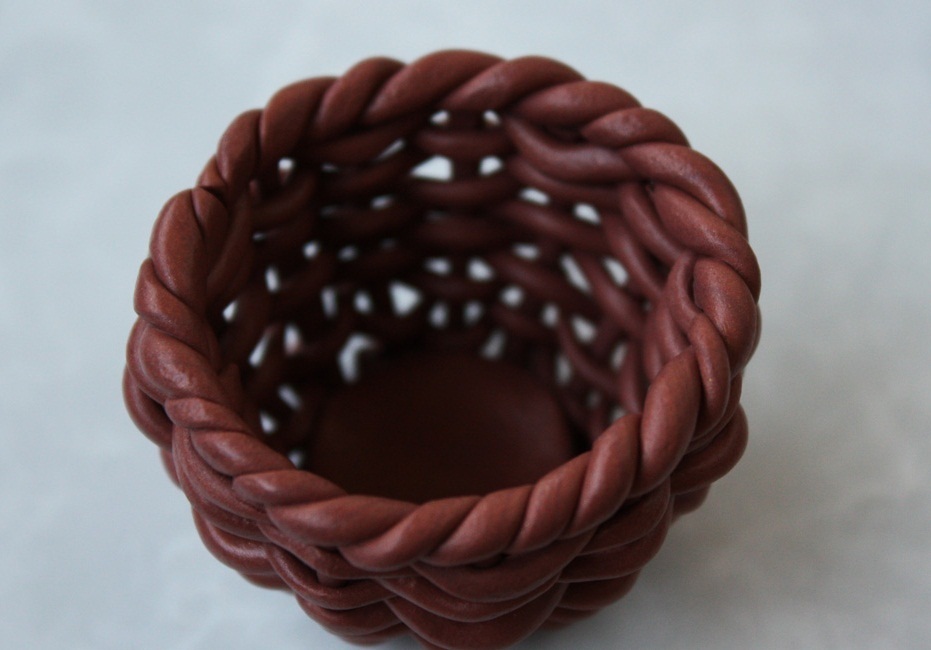 Braid of polymer clay will successfully complete the braiding of the basket body
Braid of polymer clay will successfully complete the braiding of the basket body - It remains to make the handle of the basket , for which the wire is useful. Measure out the desired length and bend the arch
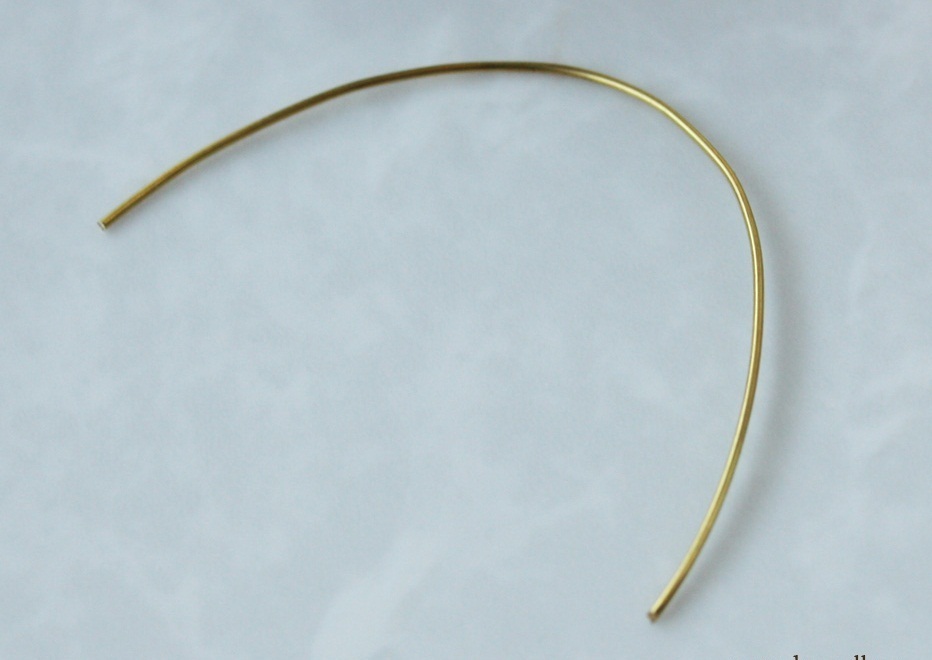 The handle frame on which the polymer clay
The handle frame on which the polymer clay - will be glued The final step is the wrapping the handle frame of the polymer clay sausage. You need to remember to leave 5 millimeters on both sides. Next, the handle is attached to the base, and the all this composition is sent to the oven for 20 minutes.
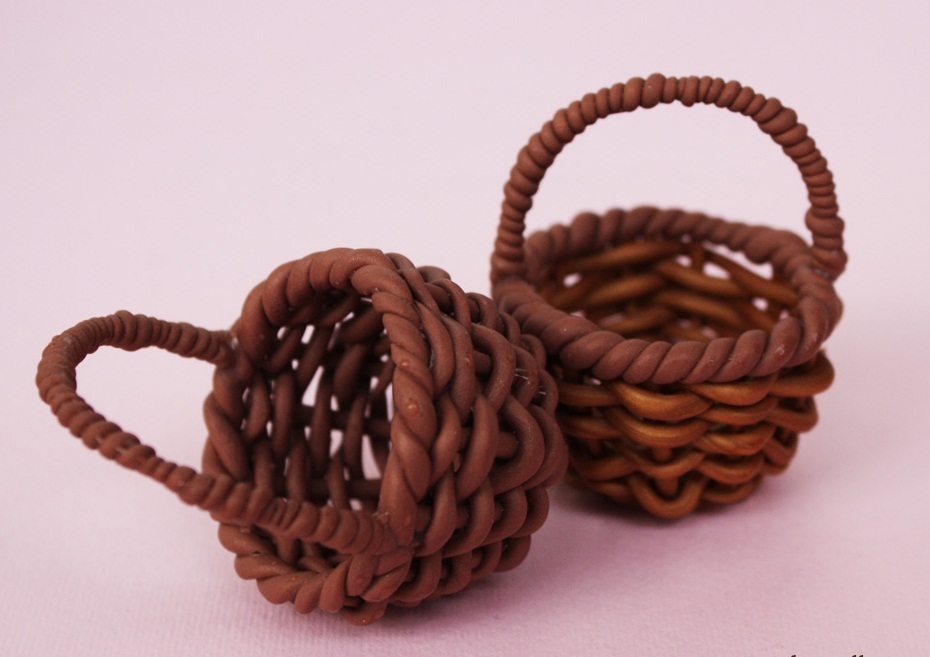 . From polymer clay, you get such a wonderful basket.
. From polymer clay, you get such a wonderful basket. . A clay doll of your own hands.
. A polymer clay doll will be an excellent gift for the child, and in the interior of an adult person it will fit well. Of course, each such doll is individual, but nevertheless the general nuances of manufacture are present.
The needlewomen with experience are convinced that the proportions of a living person for a doll do not fit - the head turns out to be small, and the hands are too long. And the is the surest way to calculate the proportions of the - it is to remember that one toy trunk is measured by seven heads. The palm is equal to the width of the face, and the foot - 1,5 palms.
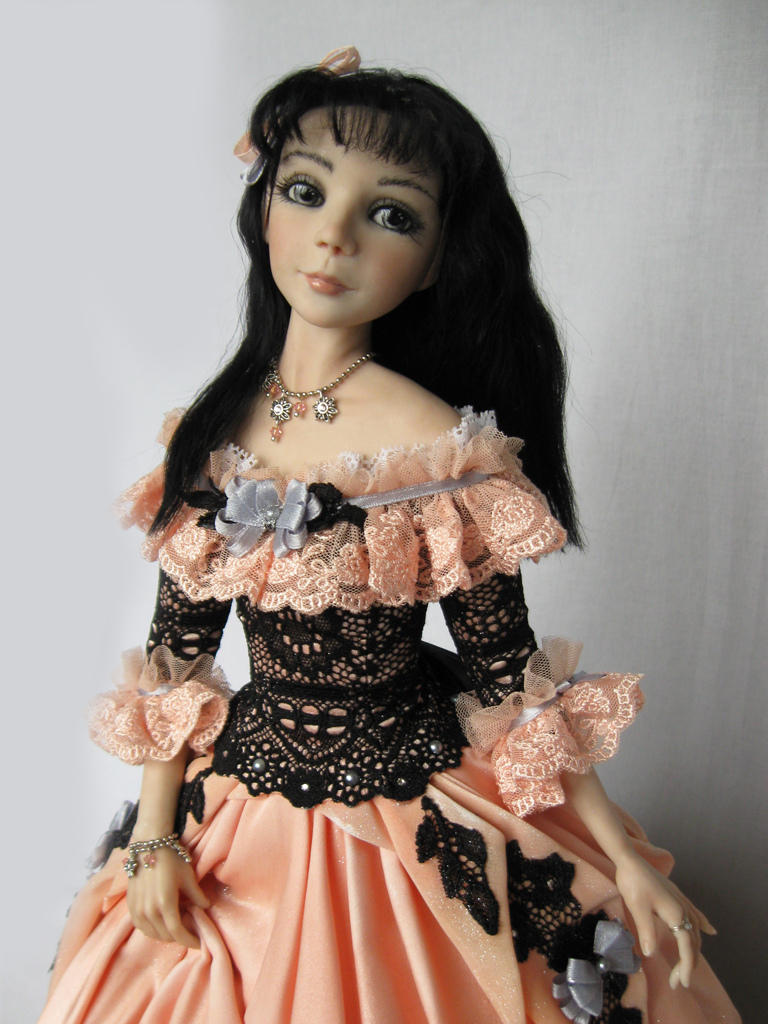 The proportions of dolls made of polymer clay are not always the same as those of a living person, but needlewomen are often advised to do
The proportions of dolls made of polymer clay are not always the same as those of a living person, but needlewomen are often advised to do . Creativity must always be started from the head, by twisting a wire loop of .On this basis, then you should wrap the foil.
IMPORTANT: Be sure to wrap the foil tightly.
Now the polymer clay comes into play, the needs to be kneaded well, after which it is covered with foil. It is important to smooth all unnecessary irregularities.
The most, perhaps, time consuming is to start drawing the facial features of .It is necessary to distinguish not only the eyes, nose, mouth, but do not forget about the forehead, the chin. To paint while it is necessary nothing - simply relief designation of features. And remember that the face should be convex.
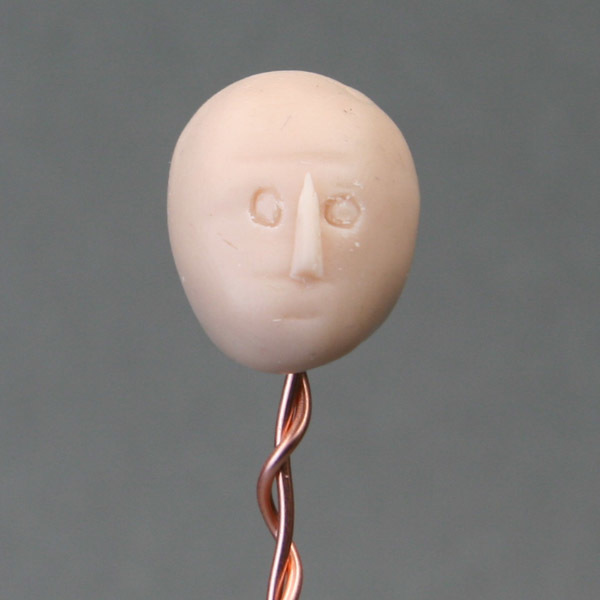 This is the face of the polymer clay in the preparatory stage
This is the face of the polymer clay in the preparatory stage . After that, the billet is placed in the furnace. The temperature of the baking depends on the recommendations of the clay producer.
Next you can make the hands of - from the clay cylindrical pieces are formed. They need to roll out.
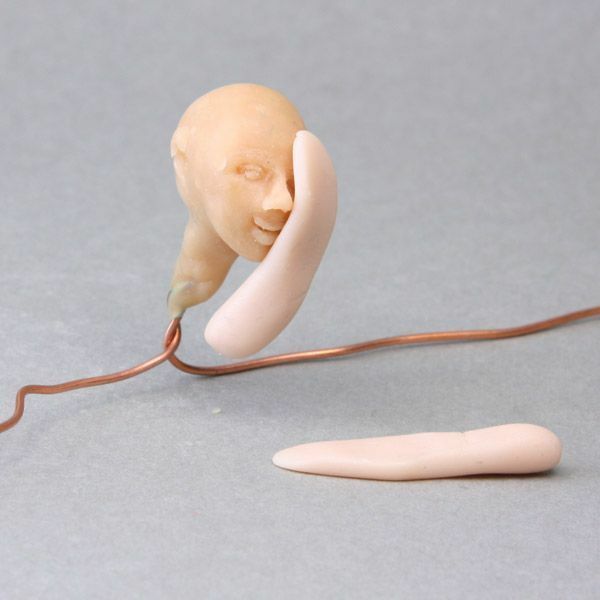 Polymer clay hands at the initial stage are cylindrical pieces of
Polymer clay hands at the initial stage are cylindrical pieces of fingers are formed using the stack. It is very important to carefully separate them without damaging them. Further, give the handles a natural, rounded outline and not forgetting about the wrinkles.
 A hand made of polymer clay must have the same folds as the current
A hand made of polymer clay must have the same folds as the current . Now can handle hands in the furnace, having previously installed them on a wire.
The production of legs begins, oddly enough, with the stop - they are made of parts, one side of which should be thicker than the other. Stack denotes fingers, wrinkles.
To the feet are joined pieces, which are then transformed into a leg up to the shin. The legs are baked in the same way as the other parts of the doll body.
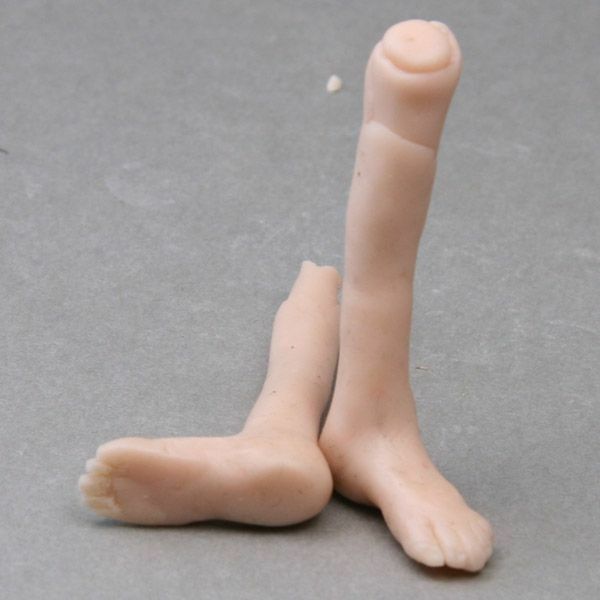 Legs made of polymer clay
Legs made of polymer clay IMPORTANT: For the feet, take the longest pieces of wire, because they will form the basic frame of the doll.
And now the disparate parts are a good time to assemble the common framework in . To do this, the wire from the head connects to the pieces from the hands, and all this is fastened with a long wire from the legs. Where the waist is planned for the pupa, the wire should be twisted.
It's time to build muscle! It is recommended that the frame be wrapped with foil, on which the polymer clay is gradually applied from the neck area.
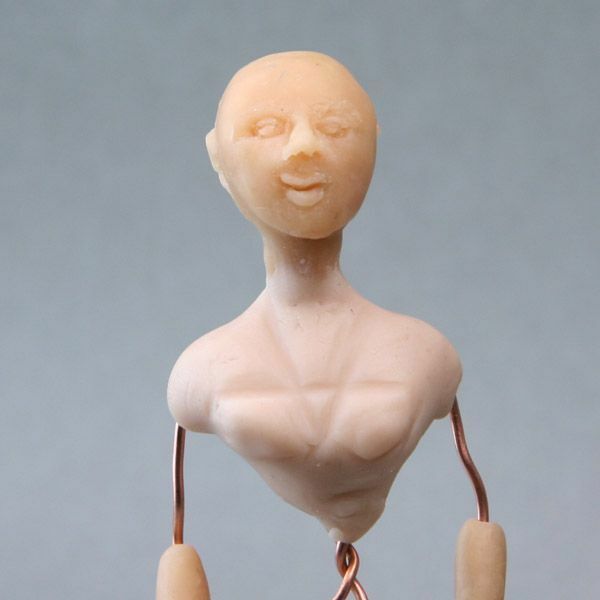 Formation of muscle mass from polymer clay
Formation of muscle mass from polymer clay Now you can bake a doll.
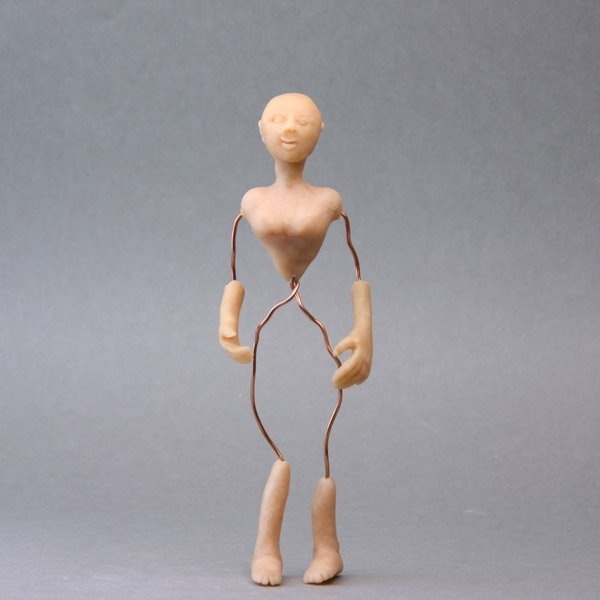 Here is a billet made of polymer clay that can be sent to the
Here is a billet made of polymer clay that can be sent to the furnace. And here comes the most interesting part: shaping the exterior. It is recommended that use acrylic paints and brushes No. 10 for face painting. For the eyes you need the thinnest brush.
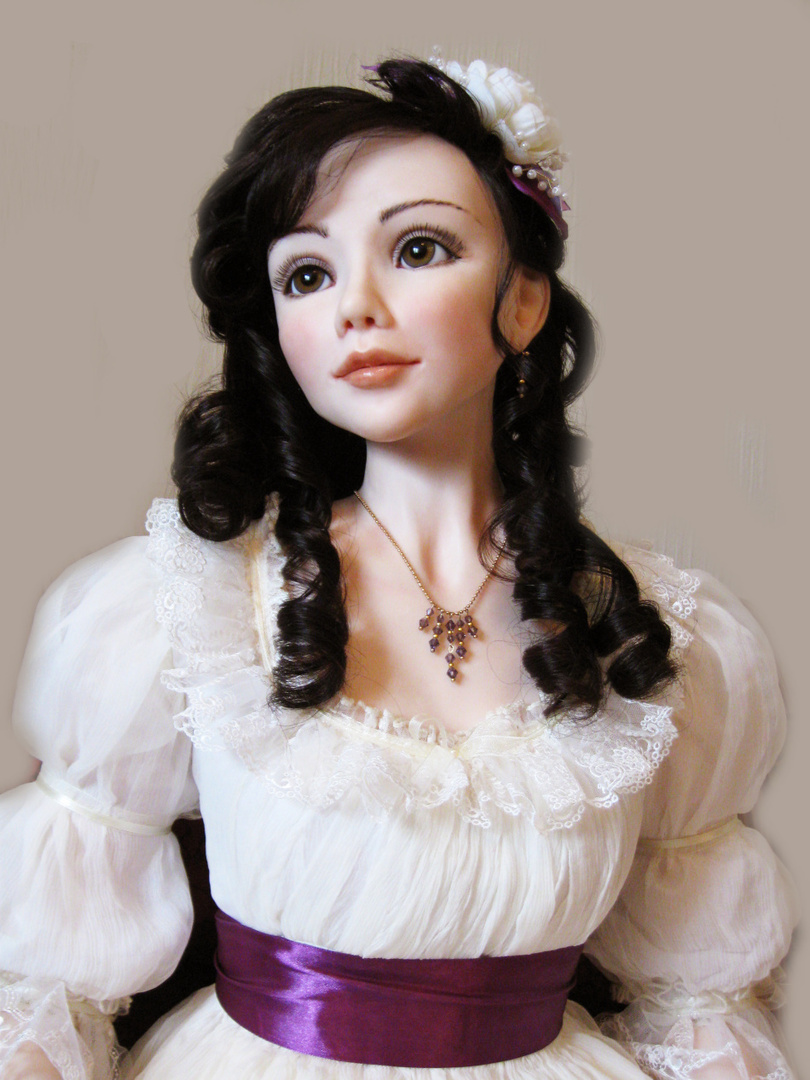 The face of a doll made of polymer clay can be quite like a living person.
The face of a doll made of polymer clay can be quite like a living person. As for the hair, , it is possible to put on a good wig, forming a piece of hair. You can form strands of silk threads.
And you can use wool for felting - from it you get just fantastic doll hair.
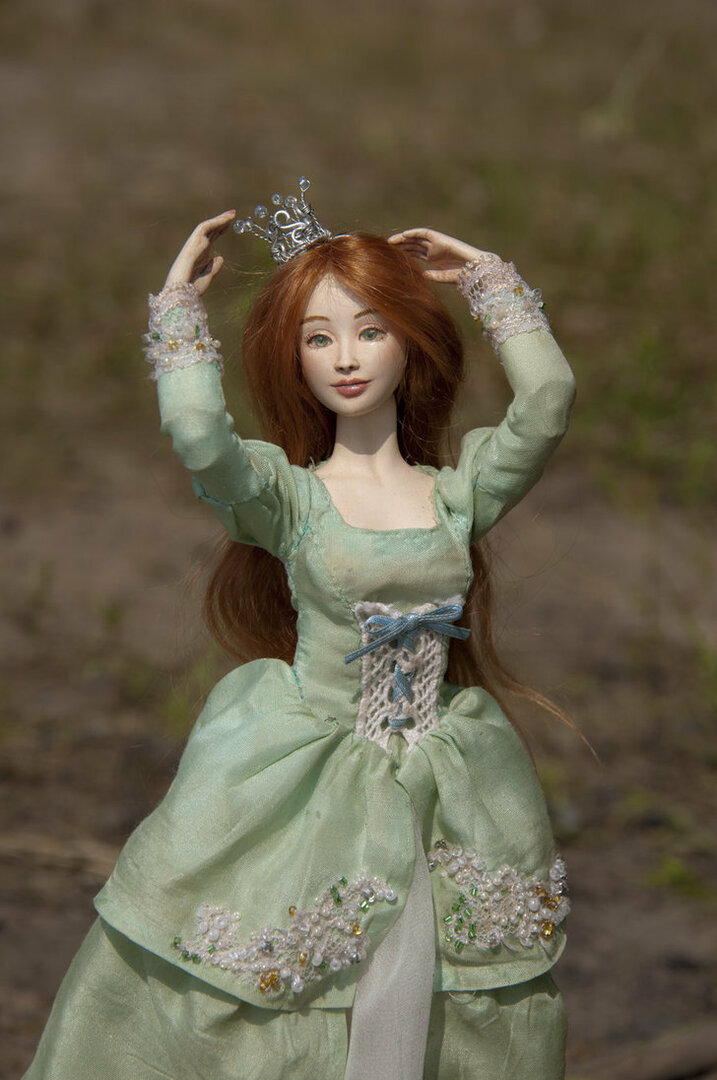 Even a doll made of polymer clay can have chic hair
Even a doll made of polymer clay can have chic hair The dress is sewn as you like, depending on the idea and the materials at hand.
 As for the outfits, they can be at the clay dolls with the brightest
As for the outfits, they can be at the clay dolls with the brightest  The clay doll of the Canadian master Martha Boers
The clay doll of the Canadian master Martha Boers 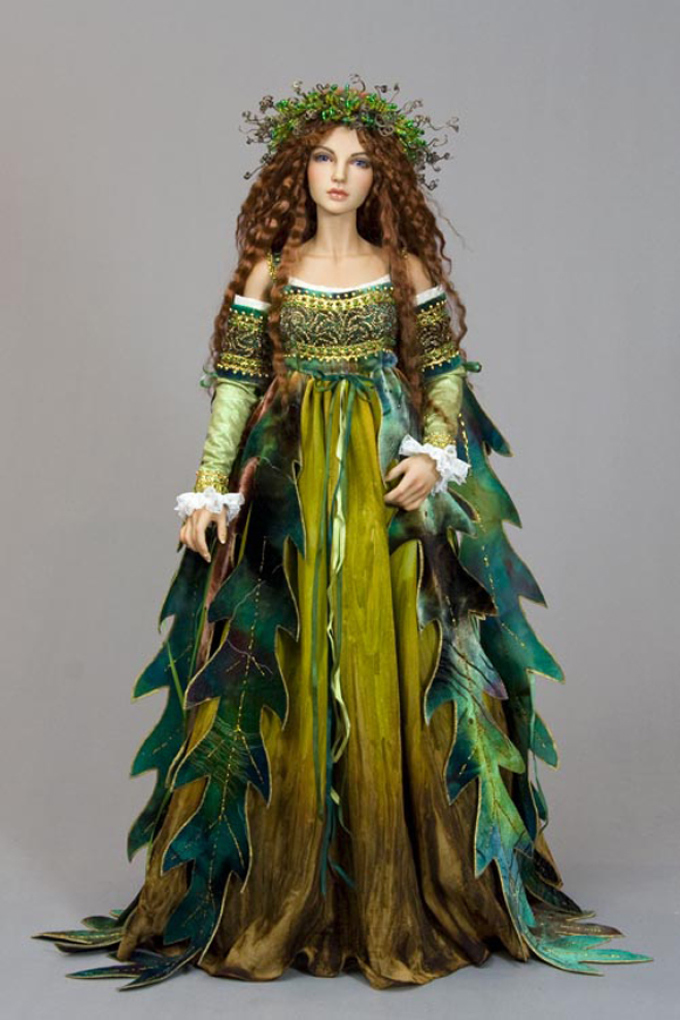 Another miracle of polymer clay from Martha Boers
Another miracle of polymer clay from Martha Boers Toys made of clay with their own hands
Toys made of polymer clay can be sculpted a lot -it all depends on your imagination. Let's try in this lesson to make the symbol of this year - fire monkey .
- First of all carefully smash the clay and create from an orange slice the oval - this is the future head of a monkey. Slightly flatten it for the face
- For the body you need to make another oval , only converted in the form of a drop
 Ovals made of polymer clay for the head and trunk
Ovals made of polymer clay for the head and trunk - The head and body are fastened so so that the body is attached to the smaller side of the drop
- Polymer clay beigeforms a thin pancake , on which you need to make a deepening
IMPORTANT: A thin toothpick for forming shapes in pieces of polymer clay is just right.
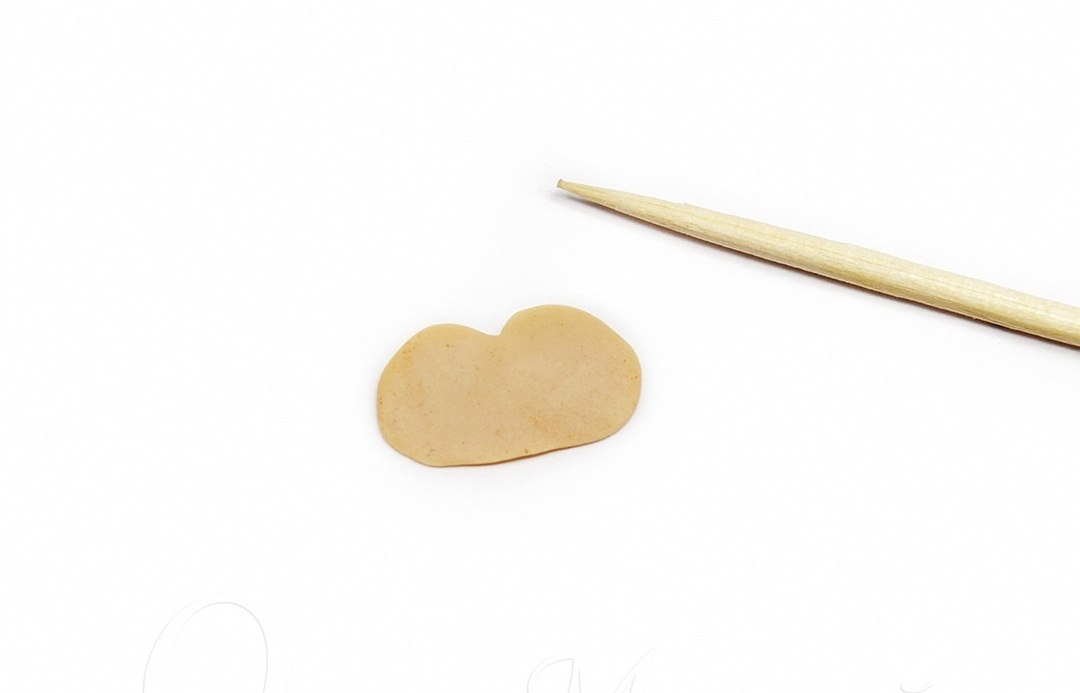 Pancake made of beige polymer clay
Pancake made of beige polymer clay - Beige pancake is superimposed on the head of .And closer to the bottom. And the indentation should "look" upward.
- A small dimple for the eyes is formed with the help of the dots. By the same principle, nostrils and mouth are designated.
- . From the black polymer clay, roll two small circles of .They are placed with light pressure in the eye sockets
- Two balls are rolled from the orange and beige clay. And beige is less orange. Of them, pancakes are made. Beige superimposed on orange
 Polymer clay ears
Polymer clay ears - The received ball is cut into two parts - these are the ears of .They are attached to the sides of the head with pressure. The joints should be smoothed out
- Monkeys can be mischievous with a bang - this is a small orange droplet, glued wide part up. The bottom should be slightly twisted
- And now the knobs are formed from 4 sausages in the form of drops. Roll smaller drops for hands. In all four sausages make grooves in the wide parts of the
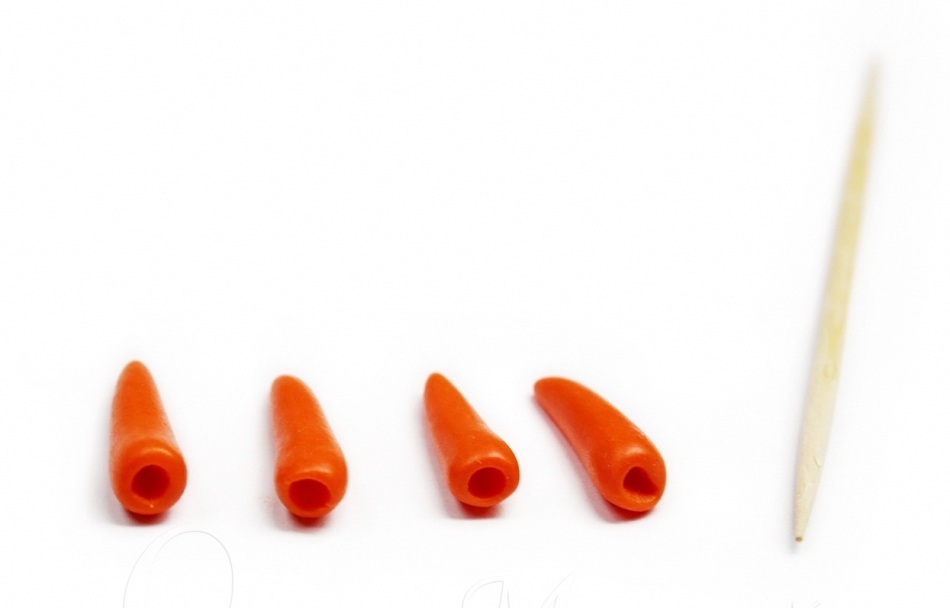 Arm-feet of polymer clay
Arm-feet of polymer clay - From the beige clay form 4 drops, and cut out their fingers on their wide parts - are the hands and feet of the .Attach them to the recesses of the hands and feet
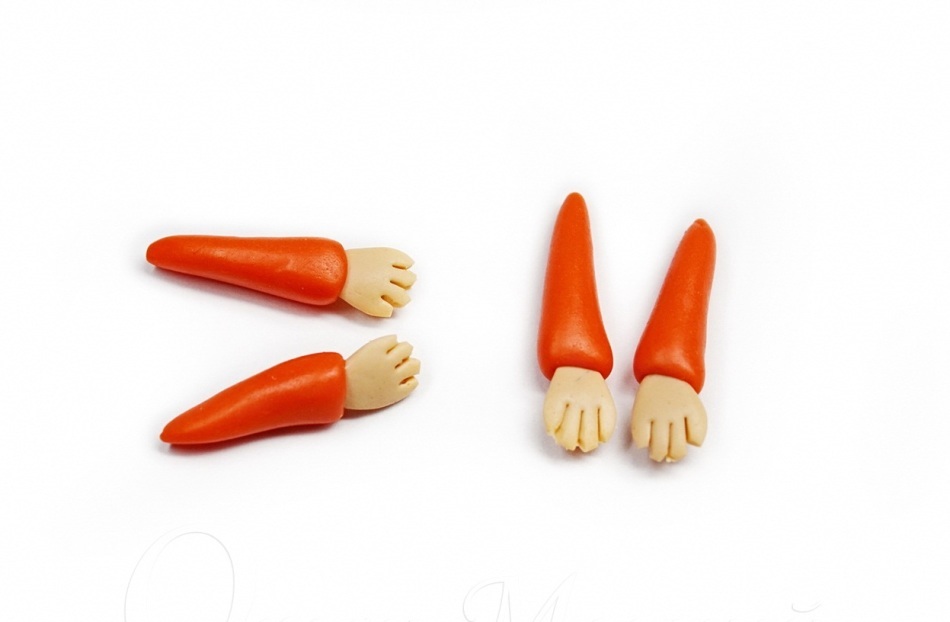 Arm-legs made of polymer clay
Arm-legs made of polymer clay - From the orange clay the tail of the is formed, sharpened on one side, and twisted as a question mark - on the other
 The clay of the polymer clay
The clay of the polymer clay - Now all parts of the body are attached totorso, and toy baked
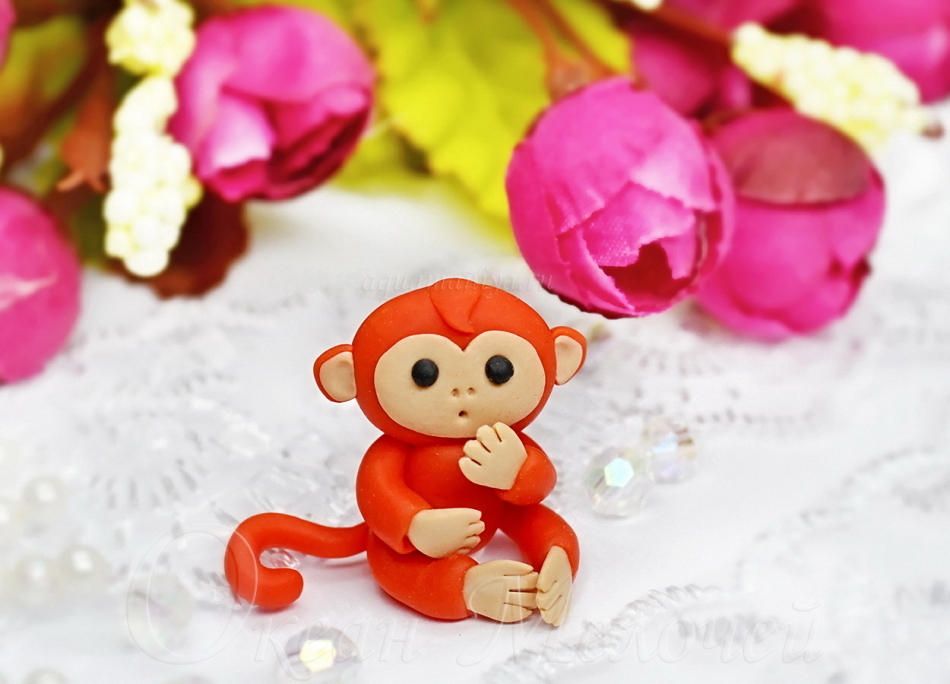 Monkey toy made of polymer clay
Monkey toy made of polymer clay Sculptures made of clay with their own hands
Garden sculpture - both interesting and functional. It's unlikely that you will want to spend money on the purchase of a finished sculpture, but you can try it on your own. For example, owl, which will need:
- Capacity for mixing material approximately liters per 5
- Approx. 6 cups of building plaster
- 500 grams polymer clay , which itself can harden
- Water
- Swords made of wood or thick wire,stacks
- Cellophane package
- Paint brushes №1 and №5
- For decoration of the owls it will be useful also gouache, glass eyes, matte varnish, nail polish yellow and black colors
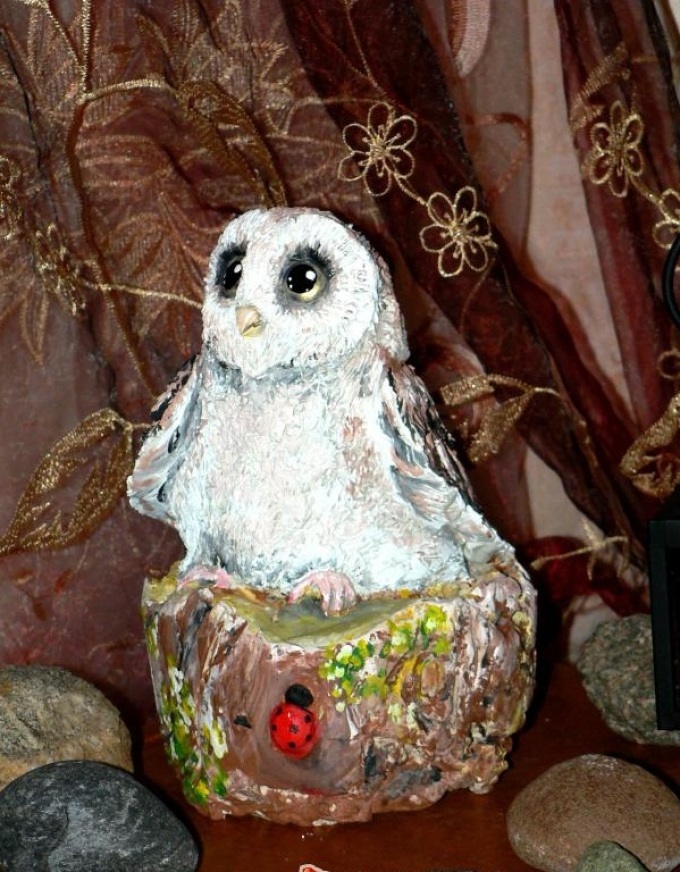 As a result of all mThe material will turn out to be such an owl made of polymer clay
As a result of all mThe material will turn out to be such an owl made of polymer clay - So, let's start with the fact that a cellophane bag needs to be densely packed in a bucket for mixing the material. Separately is mixed about 4 glasses of gypsum
IMPORTANT: The consistency of dough should resemble cottage cheese with sour cream. But there should be no lumps.
- After mixing, the dough is transferred to the bucket - it will occupy a third of the capacity. The form in which the material is mixed, in the meantime, is quickly washed. Well, the dough is inserted into the dough so that they are half sticking out of the gypsum. The gypsum needs to be leveled and leave to freeze for 2 hours
- After hardening , the plaster is taken from the bucket
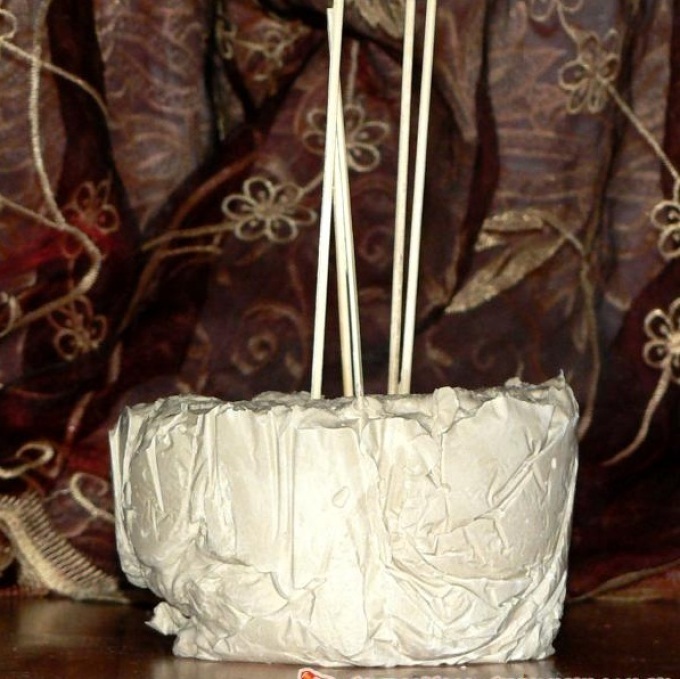 . This is how the plaster powder for the ows from the polymer clay
. This is how the plaster powder for the ows from the polymer clay - should look. Now needs to mix the gypsum up to the same state as last time. He puts on skewers. It is necessary to form outlines of an owl. The container is immediately laundered and the workpiece hardens within 24 hours
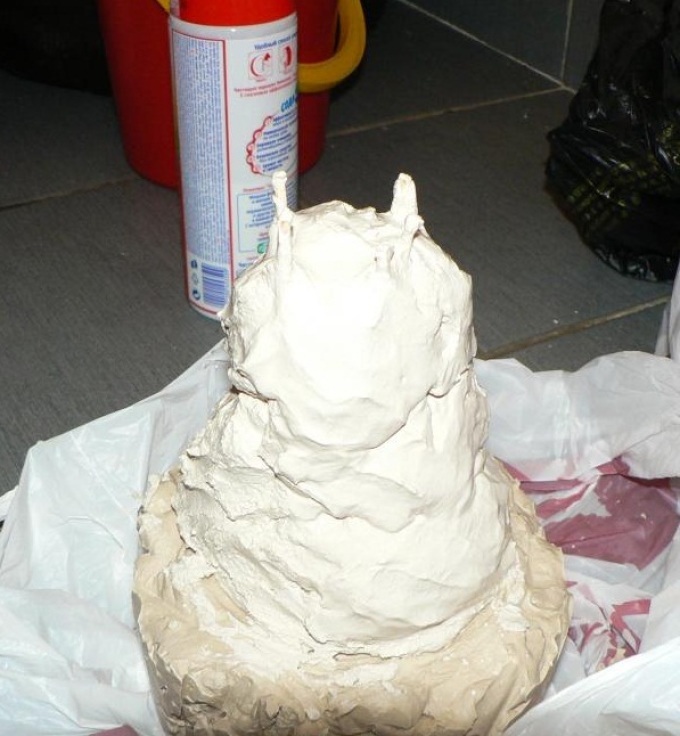 The gypsum contours of the ows made of polymer clay should look something like this
The gypsum contours of the ows made of polymer clay should look something like this - And here comes the creativity: breaking off pieces of polymer clay, stick them a little bit to the gypsum-based
IMPORTANT: After breaking off the piece, the remainder of the polymerClay immediately wrap in cellophane, otherwise it will harden.
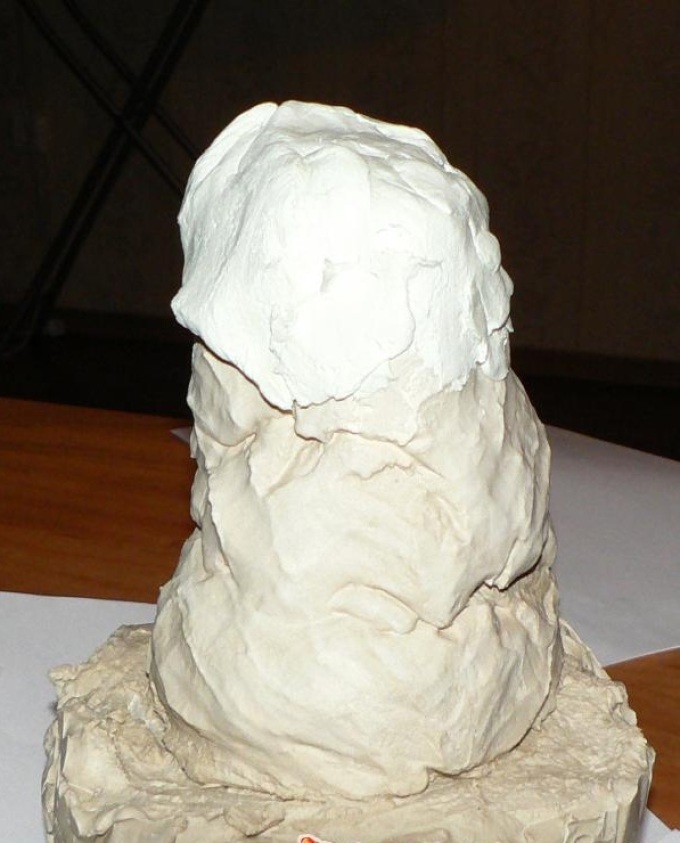 Gypsum backing should be pasted with polymeric clay
Gypsum backing should be pasted with polymeric clay - Then the feathers are drawn - preferably with the help of a gun. Glass eyes
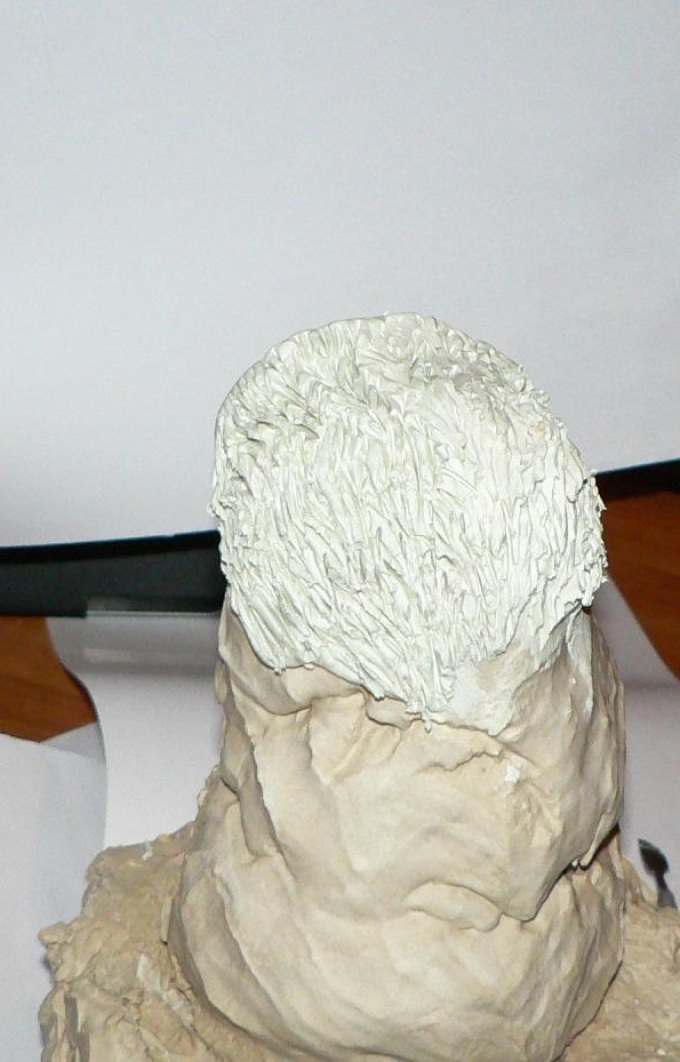 are inserted This is how the feathers from polymer clay
are inserted This is how the feathers from polymer clay 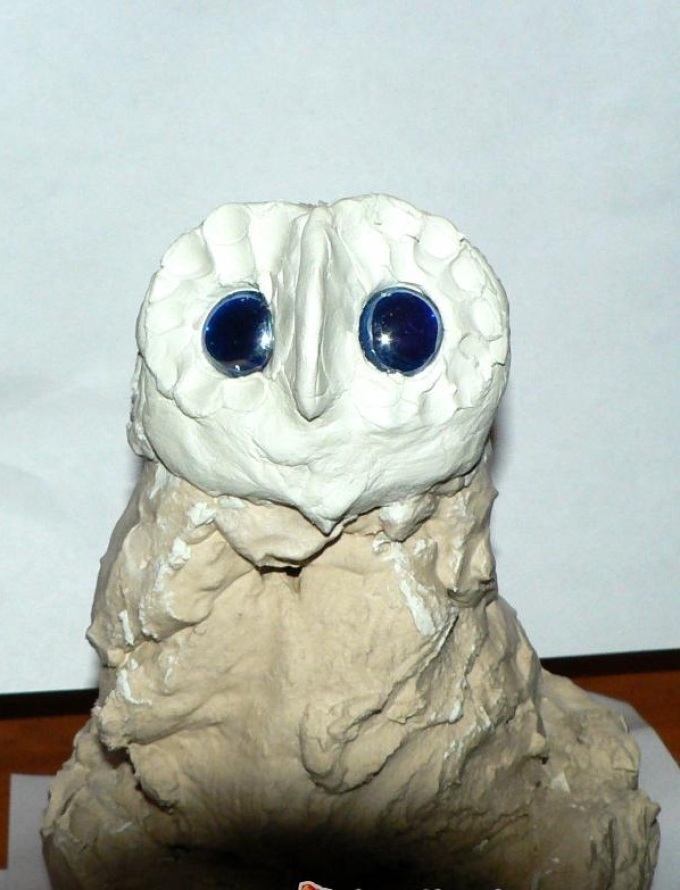 are drawn This is how you insert the owl from the polymer clay of the eye
are drawn This is how you insert the owl from the polymer clay of the eye - Formed from polymer clay back and wings
- eyes are painted with black and yellow nail polish. The advantage of such a varnish is that it is transparent, and therefore will retain the gloss of glass
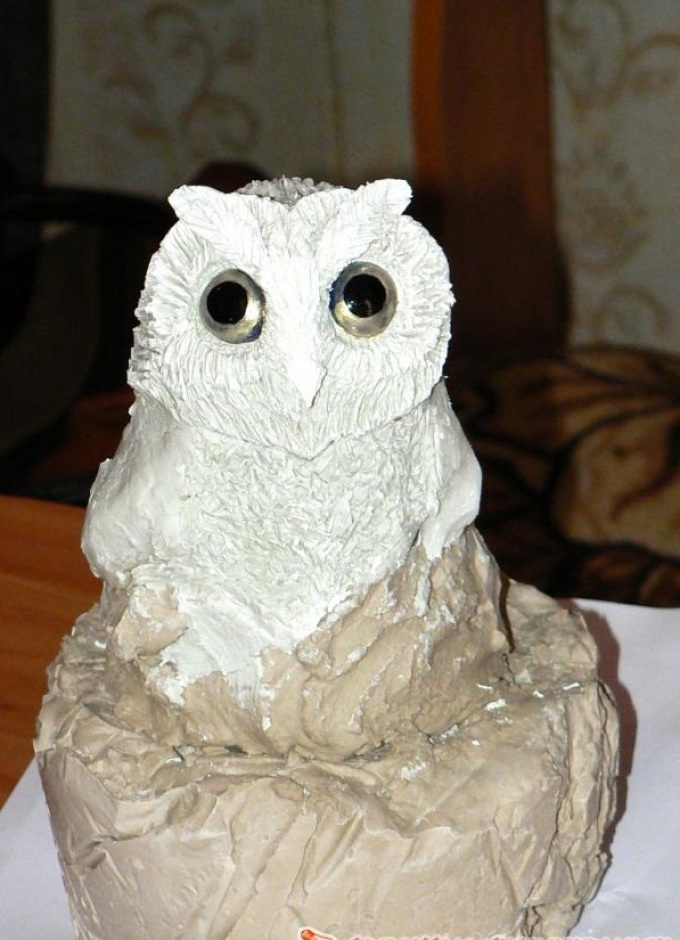 Owl made of polymer clay with plumage and eyes
Owl made of polymer clay with plumage and eyes - And now you can take ponytail .And for the sake of reliability, it must be tiered and handled by the
- . wings are drawn
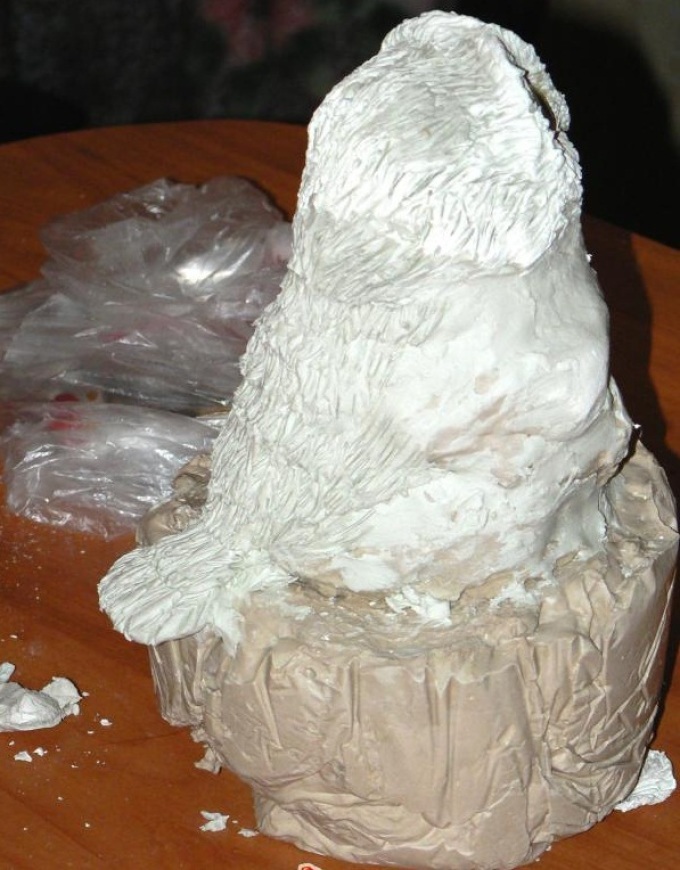 Forming the tail and wings of an owl made of polymer clay
Forming the tail and wings of an owl made of polymer clay - If there is any excess clay, can decorate additional decorations in the form of a ladybug, for example. The owl is dried and painted with gouache. Top covered with matt lacquer
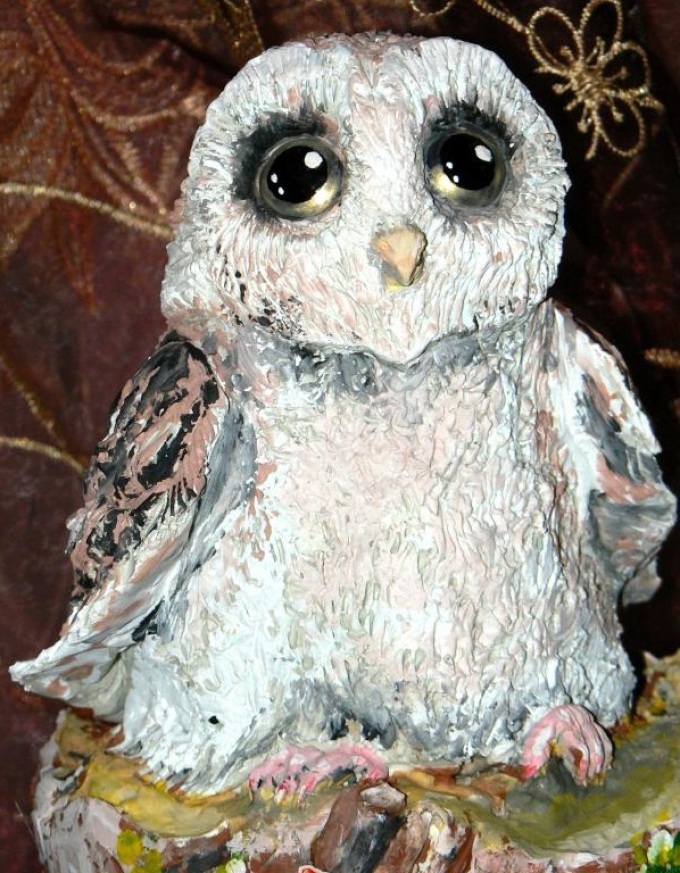 Brush covered with matt varnish, becomes more beautiful
Brush covered with matt varnish, becomes more beautiful Polymer clay cup
It is highly undesirable to completely make a cup of polymer clay, as during storage and serving of food there may be unpleasant consequences for health. But decorating a cup is quite possible. For this you need:
- Polymer clay
- Toothpicks, stacks
- Stationery knife or good blade
- Glue
- Pastel of the color that you need for the decor
- Room temperature water
Now proceed as follows:
- So first of all you need to work on the sketch,because in the process it will be quite difficult to decorate at random
- Now, drawing on the sketch, , you can start to attach polymer clay, recreating those or other details. Help yourself with toothpicks or
- stacks Once the outlines of clay are formed, can attach the pastel - it emphasizes the 3D decor effect of the
- Now fry the cup at 120 degrees
- And after this procedure, the pieces of polymer clay should be carefully uncoupled from the cup. It is best to help yourself with a stationery knife
- Rinse the cup with warm water. Dry it, degrease
- Apply each of the decor parts carefully with glue, and attach them to the cup. Go outside the decor decorate with a toothpick
IMPORTANT: The most important thing in this case - slowness. Otherwise, fragile elements will break.
- Wait 12 hours - during this time the work must dry. But to be sure of this, after 12 hours, rinse the product under running water with soap. Dry the cup - and it can be used after 12 hours
 Cup with polymer clay dog
Cup with polymer clay dog  Cup with funny polymer clay raccoon
Cup with funny polymer clay raccoon  Cup with chanterelle made from polymer clay
Cup with chanterelle made from polymer clay 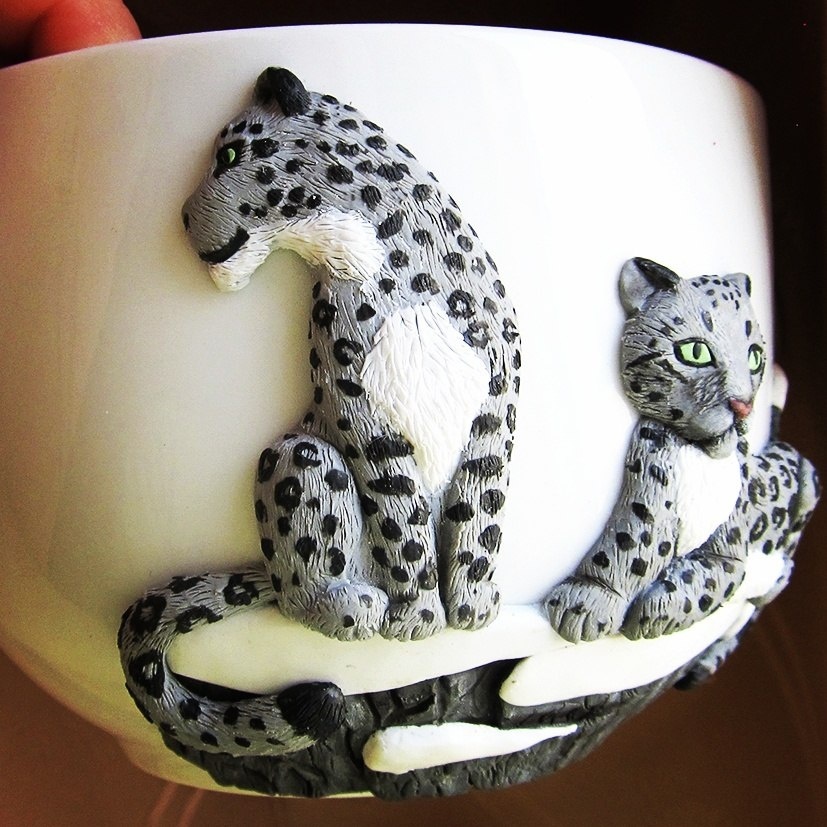 Cup with cheetahs made of polymer clay
Cup with cheetahs made of polymer clay 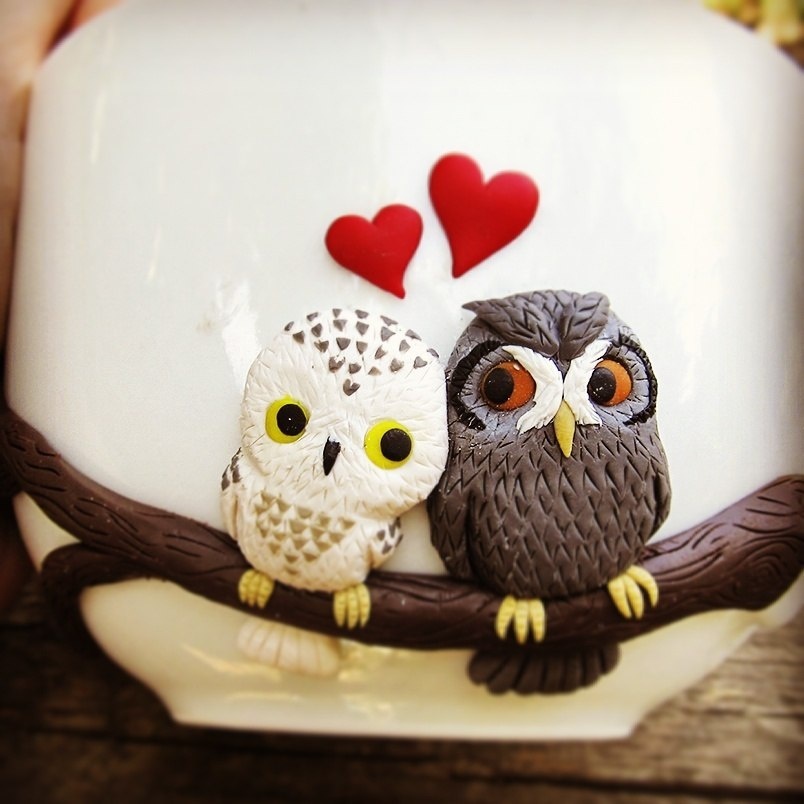 Cup with enamored polymeric clay pellets
Cup with enamored polymeric clay pellets Vasefrom polymeric clay
So, the first way to decorating some very simple vase:
- Cut out petals, twigs, leaves
- Stick all this splendor on a vase
- Draw a background, paint detailsand decor
- The vase should now be put in the oven for 20 minutes. Set the temperature to 120 degrees.
- . Let the vase cool down, cover it with varnish.
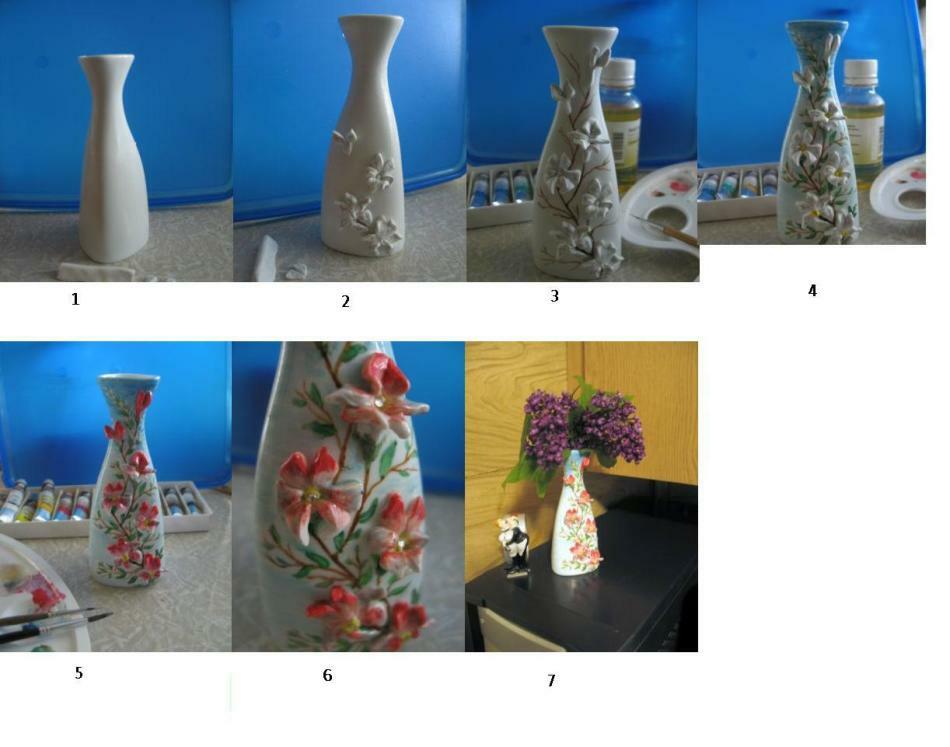 . The first way to decorate the vase with polymer clay. . We offer one more variant of glass vase design:
. The first way to decorate the vase with polymer clay. . We offer one more variant of glass vase design: - Use in this case stamps, stacks, coloring pigment in the consistency of the powder. Pour such a powder onto a layer of polymer clay, and rub it with your fingers - so you can achieve a smooth transition of shades. You can pre-define the patterns
- . Now cut out the figures from the formation. You can use scissors, or you can use a clerical knife. Let the figures be of different sizes - in design it looks just fine
- Figures should be baked, guided by instructions from the packing of clay
- Roll out one more layer of polymeric clay - the figures
will be attached to it. IMPORTANT: The base should be equal in size to the glassvase. And in terms of thickness, it should be denser than the one from which the details of the decor were cut out.
- Use a glue to attach the base layer to the vase. Spindles press into this layer, helping yourself in this work with glue
- Apply to the entire surface of the varnish with mother of pearl. Work recommended with a large brush
- Now put the vase for 5 minutes in the oven .Temperature - 265 degrees
- So we processed only one side. Repeat this algorithm for other , do not forget to let the vase cool down after each baking
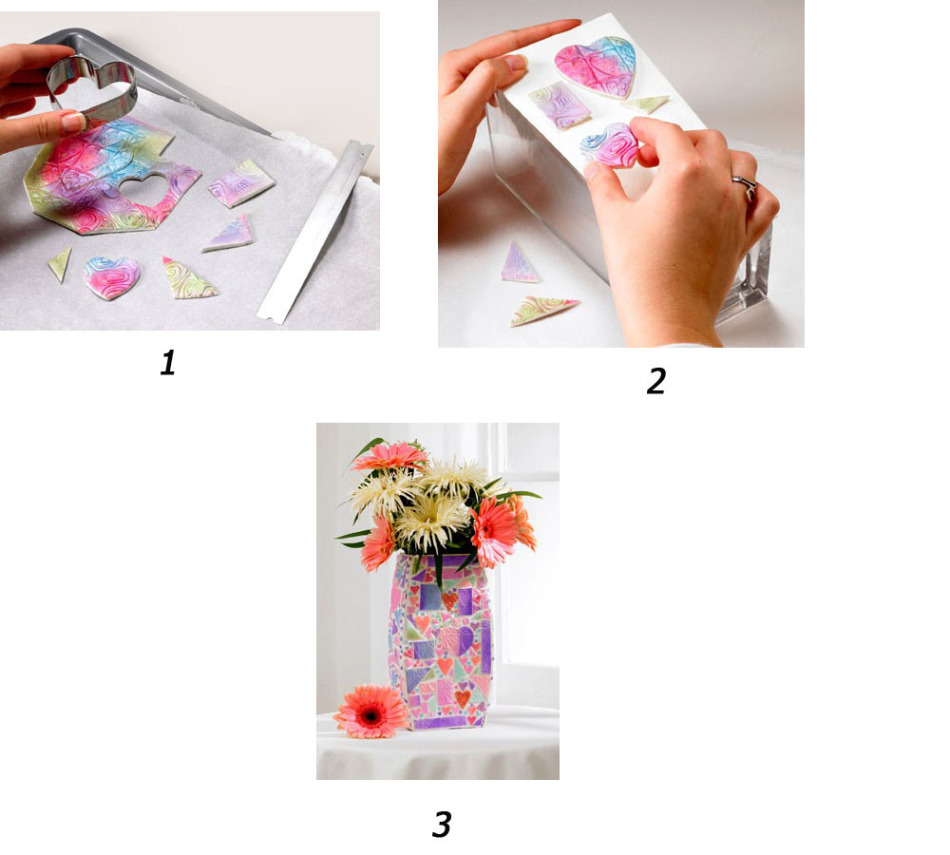 The second way to decorate the vase with polymer clay parts
The second way to decorate the vase with polymer clay parts Clay flowers with your own hands
Polymer clay produces magnificent flowers for decoration. For example, delicate cherry blossoms:
- First of all, make a sausage from pink and white polymer clay. Transitions of colors should turn out smooth, for what it is possible to use paste-machine. But the clay is needed a little, so you can try to decorate it manually
- Once the sausage is rolled, cut it into pieces in millimeters or 1.5 mm thick
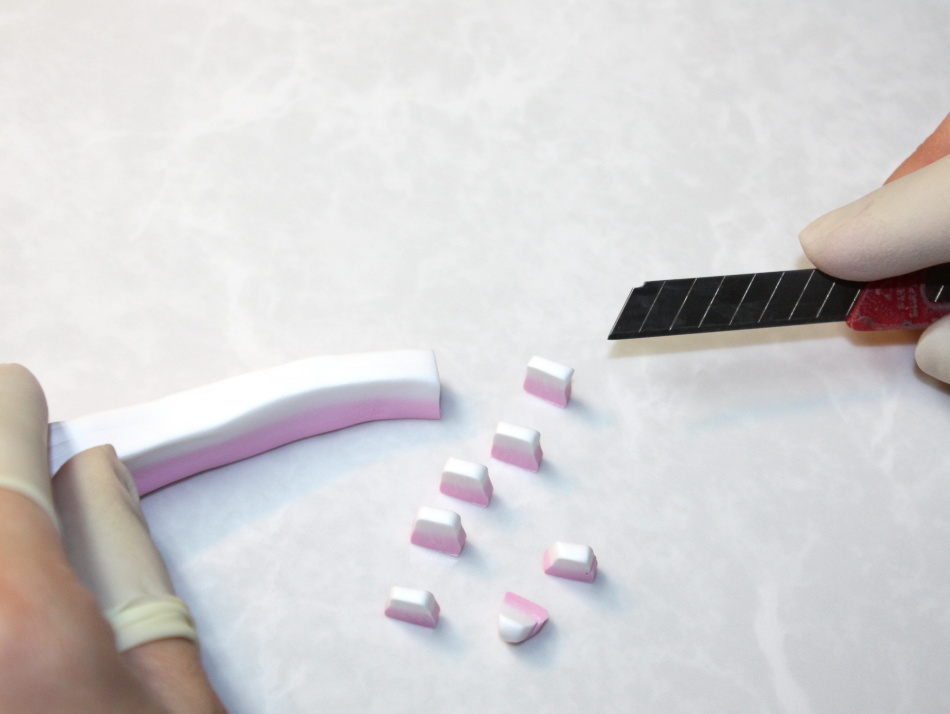 Form the polymer sausage from the polymer clay and cut it
Form the polymer sausage from the polymer clay and cut it - Form the petals .In the case of cherry blossoms, they should look like a boat
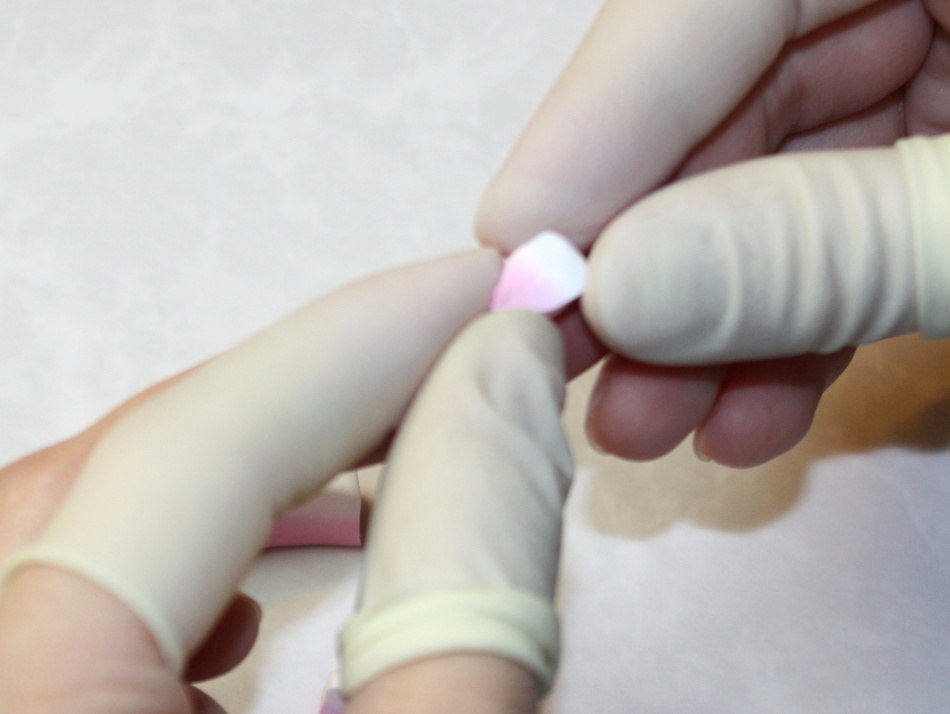 . First make a polymer clay drop
. First make a polymer clay drop 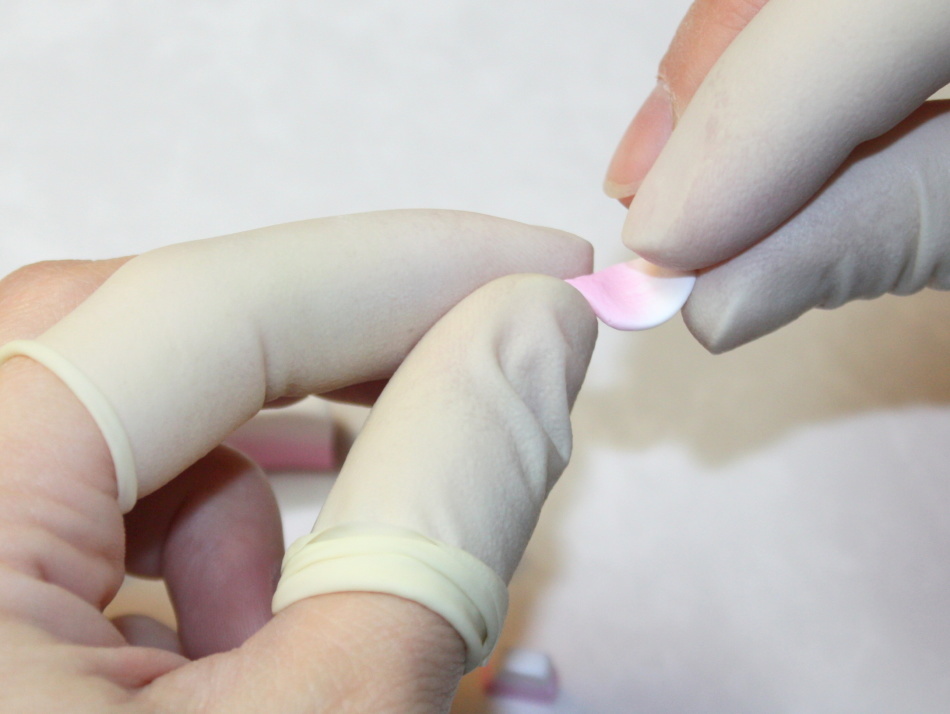 Then drop a polymer clay bend
Then drop a polymer clay bend 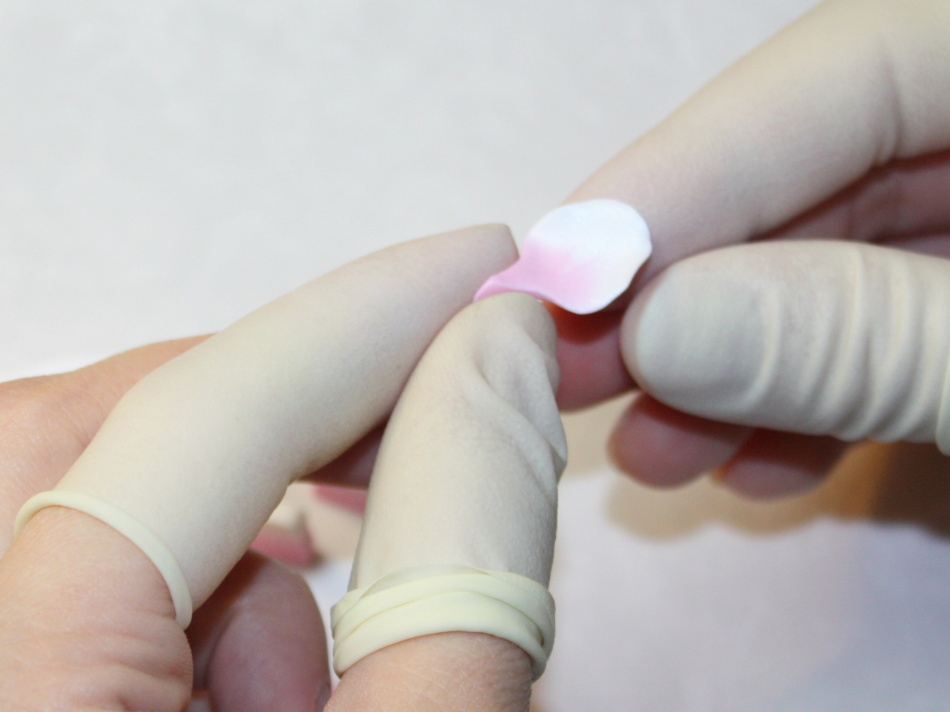 And now pin a part of the polymer clay from one end - you will get a petal
And now pin a part of the polymer clay from one end - you will get a petal - You can start collecting the flower. Connect all the petals - they should have 7 to 11 cherry blossoms. It is better to help yourself with a toothpick
IMPORTANT: Regardless of whether you help yourself with a toothpick when forming petals or not, bake a flower on a toothpick.
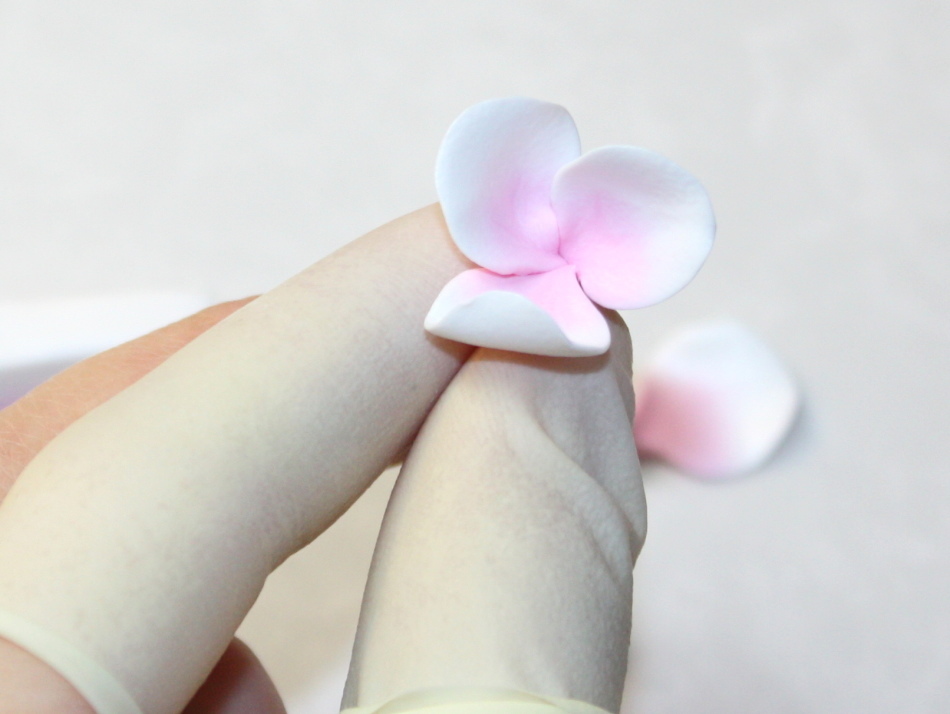 Begin collecting the petals from the polymer clay so
Begin collecting the petals from the polymer clay so 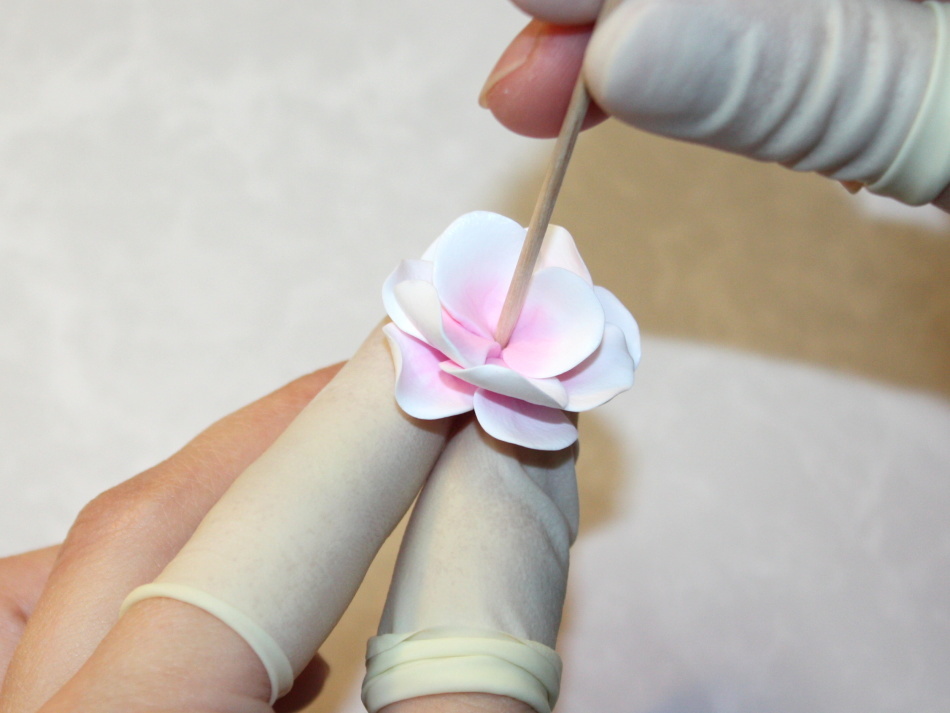 Then the collected petals of the polymer clay will take the form
Then the collected petals of the polymer clay will take the form - Now make a cherry blossom , the principle of which, by the way, is the same for all colors. So, take a thin wire not more than 0.3 millimeters thick, and a length of 15 centimeters
- Form at one end of the wire a loop, connect the loop to a piece of polymer clay. A piece of
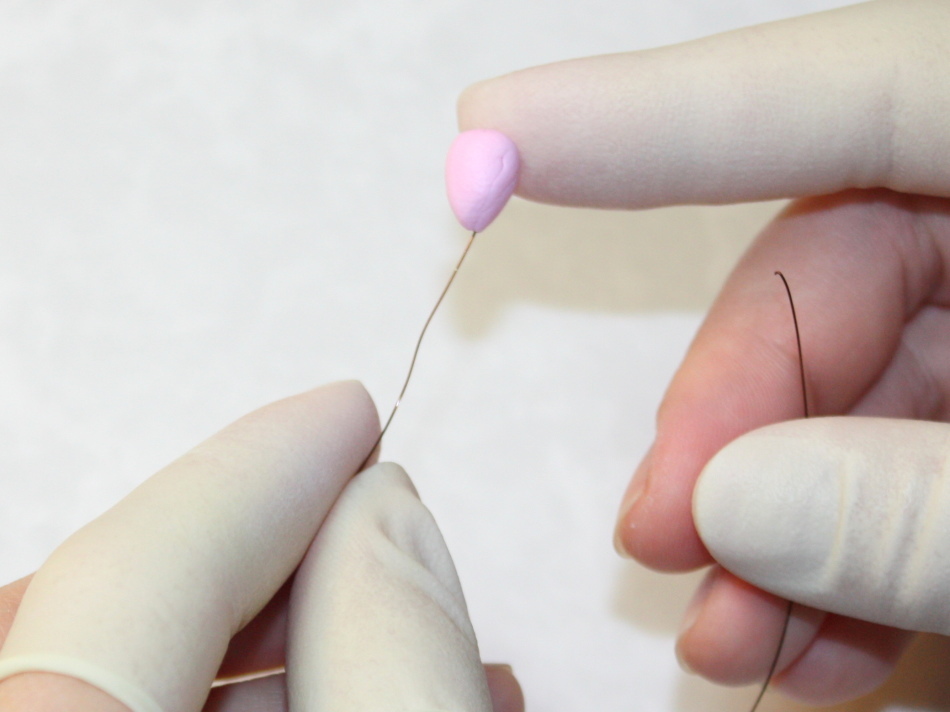 drops from a piece in advance It should be a polymer clay billet for a bud
drops from a piece in advance It should be a polymer clay billet for a bud - Create 3 more petals , glue them on a drop of
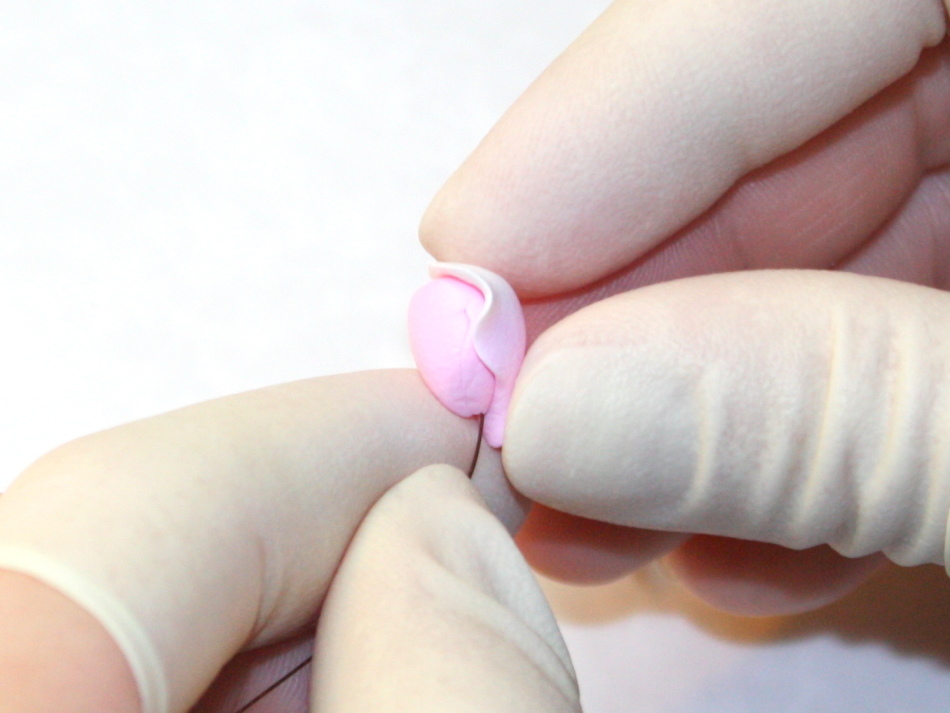 Stick petals on a drop of polymer clay
Stick petals on a drop of polymer clay 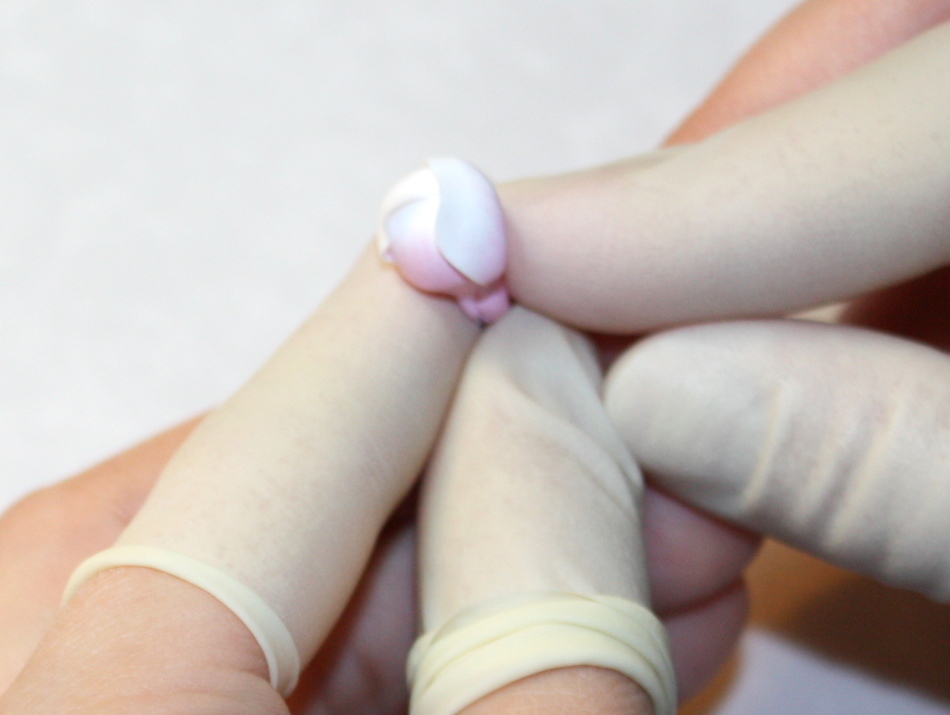 The result is a bud of polymer clay
The result is a bud of polymer clay - For greater naturalness better to do the creation of the seismic .The sakura, as well as the rose, cherry, sepals have 5 petals
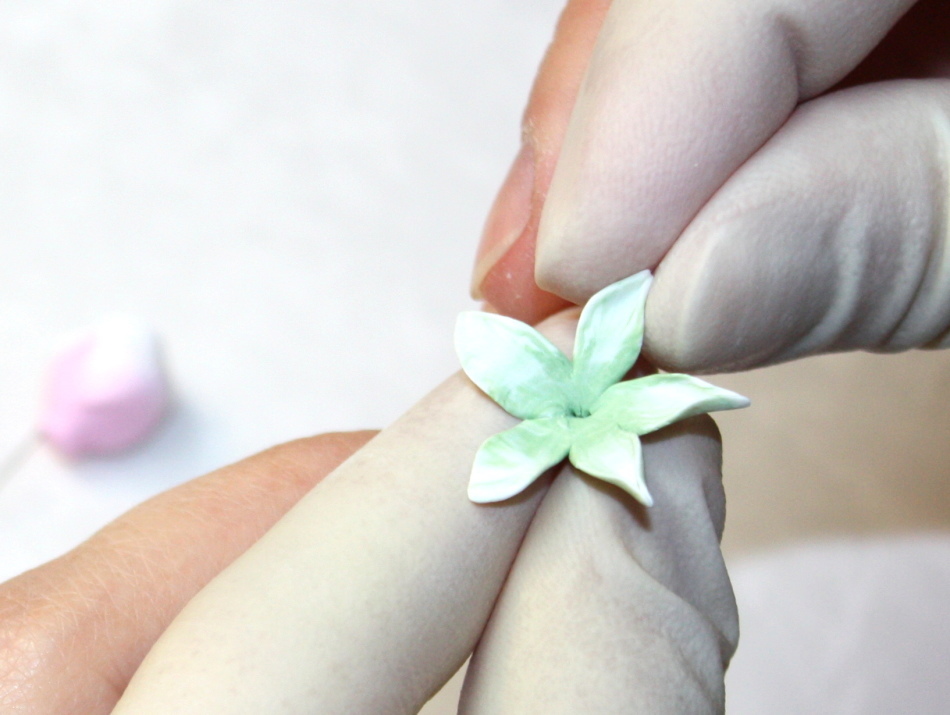 The sepal of polymeric clay
The sepal of polymeric clay - Put sepal on the wire , and attach it to the bottom of the bud
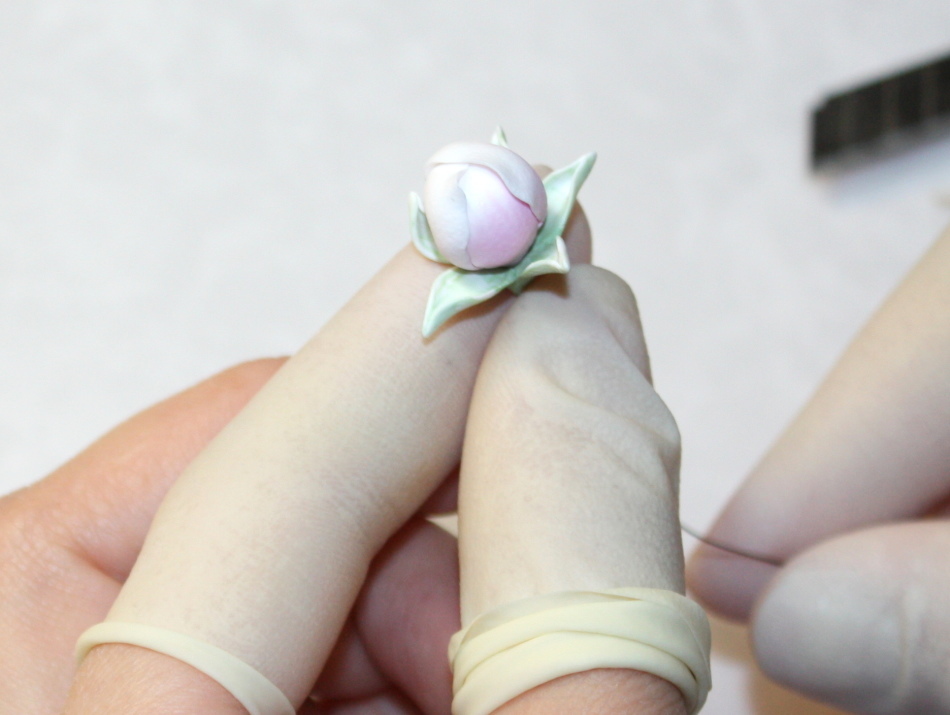 The sepal with the bud of polymer clay
The sepal with the bud of polymer clay - Now lay the paper napkin on the ceramic tile - and bake !
 Here is a flower of sakura made from polymer clay
Here is a flower of sakura made from polymer clay Tandoor of clay with their own hands
Tandoor is a great find for residents of private houses or owners of villas! Such a stove, the technology of which lasts for centuries, and the meat roasts evenly, and the bread makes a fragrant.
IMPORTANT: It should be noted that this tandyr is made exclusively of clay - only because of it the furnace will have thermal insulation properties. Really impressive is that it keeps the temperature suitable for cooking, about 3 or 4 hours.
What is the device of this furnace? It is an earthen vessel, tapering upward - food is placed there. And traction is provided thanks to the blower below. The bottom is lined with brick, and clay, salt or sand is placed between clay and clay to preserve heat.
In addition to all of the above, you will have to stock yourself with sheep wool or camel - this will allow the oven to not crack when setting high temperatures.
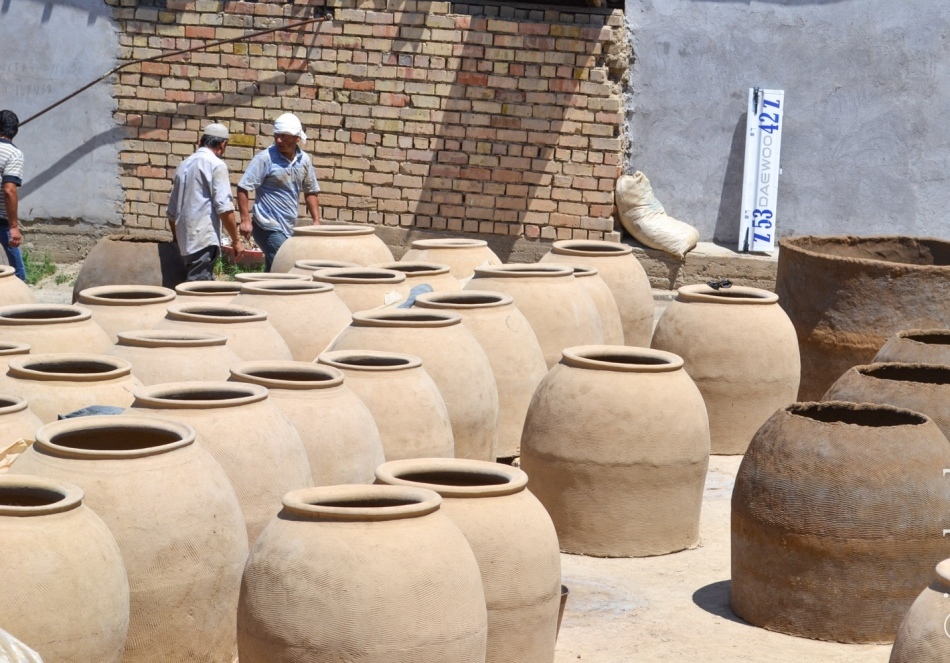 This is how a real clay tandoor from clay
This is how a real clay tandoor from clay - So, the first thing about is to mix clay with wool. Pre-cut the wool with 10-15 millimeters of fibers
IMPORTANT: The mixture in consistency should resemble thick sour cream, have a viscosity.
- This mixture must be left until it reaches a suitable state for at least a week. But during this time stir the workpiece, otherwise it can dry unevenly. And watch that water does not accumulate from above - otherwise the tandyr will be covered with cracks.
- . If the workpiece looks like a dense clay at the end of the week - you did it right! From such plasticine, blot oblong sheets, the thickness of which should be at least 5 centimeters. That's where the tandoor 1.5 meters high is formed, the diameter of the wide part is a meter, and the diameter of the neck is 0.5 meters.
IMPORTANT: Be sure to leave a hole at the side - it is necessary for blowing.
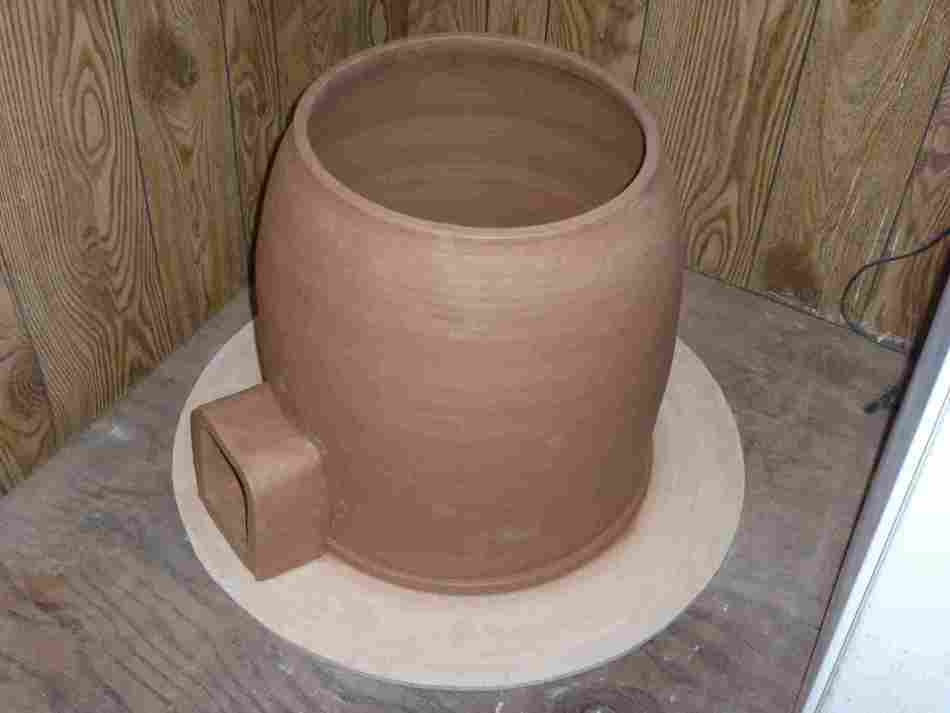 Approximately this hole should be at the clay kiln
Approximately this hole should be at the clay kiln - Leave this workpiece for a month for complete drying
- Now you can overlay the workpiece with bricks. The same clay is used as the solution. You can replace it with a mixture of clay, plasticizer and quartz sand
- From the inside, the oven is smeared with cotton oil
- And now - firing the until it resembles ceramics. The temperature rises slowly, so do not worry if the burning takes a day.
Decorations made of polymer clay
Polymer clay produces excellent ornaments - bracelets, necklaces, rings. But they will be discussed in another article.
As you can see, polymer clay is just a godsend for creative people. From it you can do a lot of excellent things that will bring positive, cozy and beneficial to your life.
It's unlikely that you can keep from buying such a thing, and if you start to be interested in the process of working with polymer clay, then you can hardly resist trying to make something yourself.
